#love love love the design and characterization throughout the years
Note
asking for Velvette Dx and/or head canons if it's not too much hassle! Plz and ty!
tw // suicide
I would like to preface all my posts on headcanons related to psychology and mental illness with a disclaimer: diagnosing mental conditions, especially personality disorders, can be extremely challenging. It's a complicated process that relies heavily on a psychologist's interpretation of facts, making it susceptible to biases. Personality disorders cannot be diagnosed based on surface-level observations and are not just labels that we can assign to people like in the case of MBTI. Additionally, I am not a clinician with any expertise in diagnosing people. Therefore, the following post should not be taken as a reliable professional opinion. It's simply my interpretation of the internal mechanisms that may be responsible for the behavior of certain characters in my fan fiction. Furthermore, I want to make it clear that I have no intention of stigmatizing people with personality disorders by associating them with villains. A personality disorder does not determine someone's character or make them a bad person. Some characters may be evil because of the choices they make, not as a result of their mental conditions.
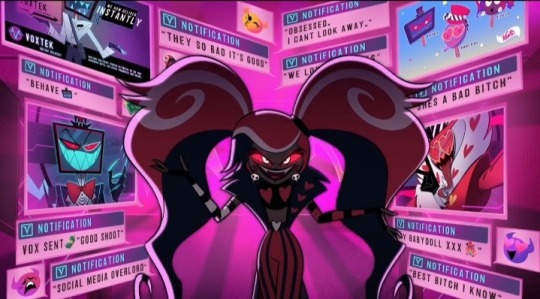
So, as I mentioned, I headcanon Velvette as having an Antisocial Personality Disorder. It is characterized by lack of sympathy or empathy for the rights of others, while simultaneously acting charming and interpersonally manipulative.
❤️ Throughout her childhood, Velvette lived exclusively with her father in the impoverished and sketchy part of the city. Her father worked a lot to earn them living but at the same time he drank a lot and while drunk tend to be aggressive. Also he surrounded himself with bad people. In my mind Velvette can deal with Vox and Val's shit so well because since she was little she was surrounded by unpredictable and violent men. At this point she couldn't be less scared of them.
❤️ She endured relentless bullying during her school years due to her inability to afford stylish clothes and gadgets. This was particularly hurtful for her, given her deep passion for fashion. Velvette devoted all her free time to design stunning looks, harboring a fervent desire to be able to wear them.
❤️ Around 12, she figured that following rules was pointless, being in a disadvantaged position due to her family's poverty. The sole way to boost her social status, in her view, was to break those rules. This extended beyond minor offenses like stealing groceries; she engaged in more serious crimes, such as taking money, clothes, and jewelry from stores and individuals. She never felt any remorse for these actions; to her, they were merely a means to achieve her goals, regardless of the harm inflicted on others.
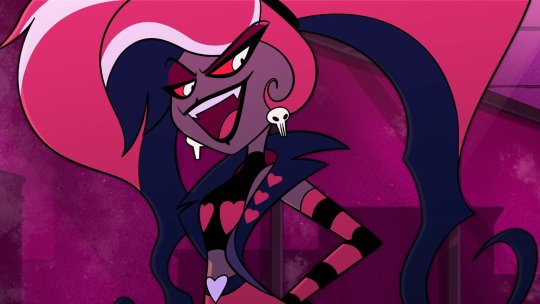
❤️ She never finished her education because sticking to school rules wasn't her forte. She had the smarts and charm to sidestep juvenile detention. Despite concerns from a few individuals, we all know how well the system deals with "troubled teens." Besides, her father wasn't bothered by psychologists' opinions as long as she was bringing in some cash.
❤️ As a young woman she used her charm to manipulate men and take advantage over them. While she contemplated sex work as an easy money-making avenue, she found men too repulsive to engage in it. Instead, her preferred method involved blackmail – she seduced married men, particularly the submissive ones drawn to her aggression and coldness. Through this, she gathered intelligence and skillfully weaponized it against them.
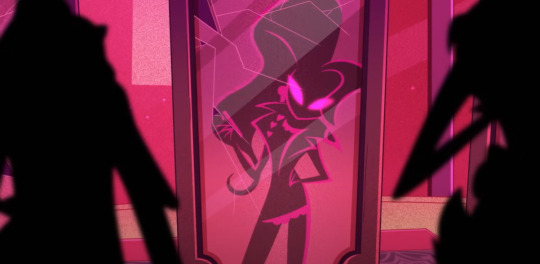
❤️ At some point, she blew up as this super popular influencer. It kicked off with her sharing cool, low-cost looks on the internet. People loved her sassy attitude and creative stuff. But as she got more famous, it stopped being about creativity and turned into a power trip. She built a cult-like following around herself and started abusing her power. Being openly mean worked in her favor online – people ate it up, especially when she got into online fights. No matter how wild it got, no one could successfully cancell her. Actually, I think Vox really admires her talent for stirring up drama. He pushed her several times to get on some reality show, thinking it'd make the ratings explode. But the darkest stuff Velvette pulled wasn't out there for everyone to see. It all went down in her DMs. She justified it as "finally getting justice from rich white brats," using her influence to get teens to pull off crimes and risky stuff. She even manipulated at least two depressed kids into taking their own lives. When shit hit the fan, and she knew prison was coming, she took it as one last chance to torment people. During a "live stream apology," she commmited suicide in front of thousands of people.
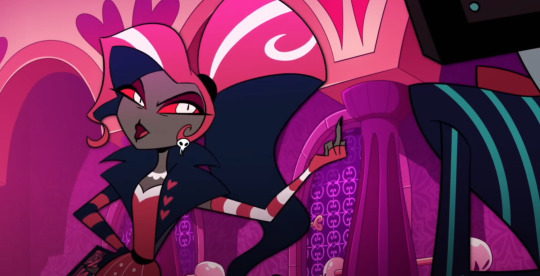
❤️ In the show, it's evident that she's downright rude. Not just to Carmilla and the other overlords, but also towards Vox and her own employees. The lack of sensitivity and respect for others, coupled with a strong sense of superiority and being extremely opinionated, are typical traits associated with Antisocial Personality Disorder (APD). My girl literally got song called Respectless.
❤️ She disregards any kind of authorities and when someone tries to impose their will onto her, she's going berserk.
❤️ She genuinely couldn't care less about what people think of her; she despises people that much. In fact, being hated now excites her because she knows she's untouchable and influential and it makes everyone even more angry.
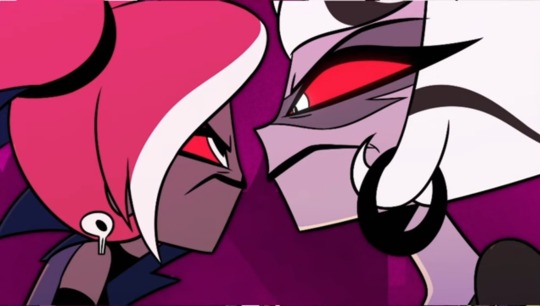
❤️ She's extremely reckless, even if she knows it could hurt her – another trait associated with APD. While we observe Vox and Valentino able to behave when necessary, Velvette storms into overlords' meetings guns blazing and starts with insulting everyone, even though she aims to convince them to align with Vs.
❤️ She struggles to form genuine connections with other people. Still, she's got a soft spot for Vox and Val, sort of considering them her friends. At the same time, she sees them as just a couple of guys she can easily play to her advantage.
Vox hc | Valentino hc
#hazbin hotel#hazbin hotel velvette#velvette#vox hazbin hotel#valention hazbin hotel#vox#valentino#character analysis#headcanon#ask
146 notes
·
View notes
Text
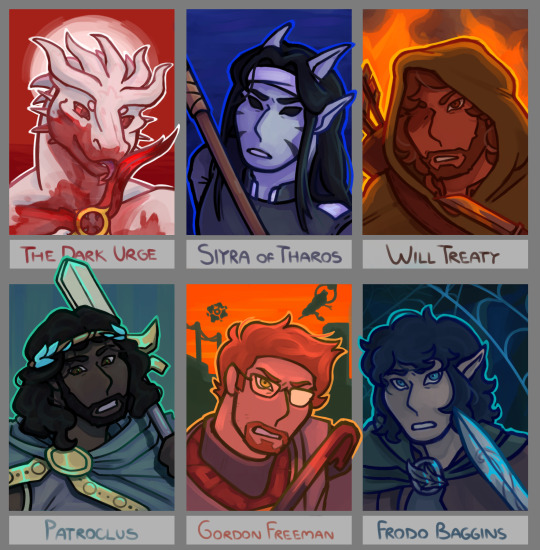
Here's the draw six fanarts meme I decided to participate in 4 years late
In true burnin0akleaves spirit I didn't ask anyone for requests and just went ahead with all of the characters that have been the most impactful/important to me, so there is a high chance you've seen me draw these guys before.
By the way, unlike the rest of the blorbos here Siyra is an original character and belongs to @nineteen-rats!
Close-ups and rambles under the cut because it's my blog
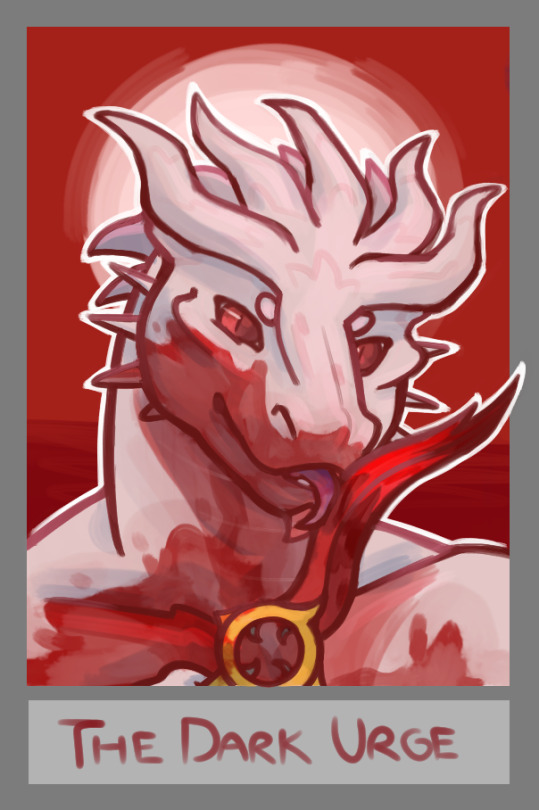
Ohh the Dark Urge. My latest obsession. I love his design so much, I'm a slut for white/red color schemes, but I feel like it's a double edged sword that takes you out of the horrors he's commiting at the same time?
Durge is supposed to be murder incarnate, someone that does every fucked up thing related to death imaginable; but when you see a giant lizard eating babies or humping corpses, it dulls the effect a bit since you automatically view it as an animalistic act. Dragonborns are obviously a fully sentient humanoid race in-universe; but when the violence you're seeing is already toeing the line between horrifying and hilarious, seeing a scalie doing it just pushes it over the line. I still think it works really well most of the time and I'm very glad that this is the default durge we get! It's just funny to me that when you choose to play as the giant lizard, the dark and disgusting horror story turns into the hilariously edgy bloodfest.
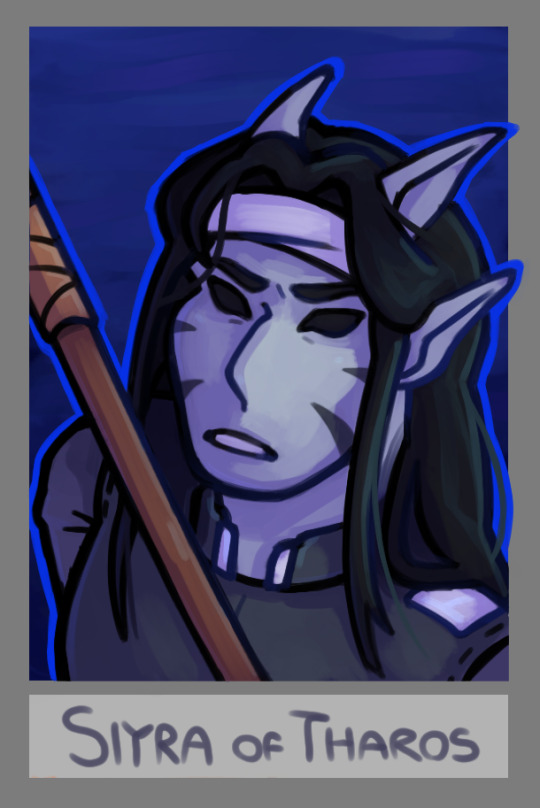
Reminding everyone again that Siyra belongs to @nineteen-rats! I love this man so so so much. I am the Siyra fandom. I am the number one Siyra fanartist. He did nothing wrong and I will defend his every decision. I also hope terrible horrors befall him and that his actions keep him awake for the rest of his life. Pookie bear xoxo
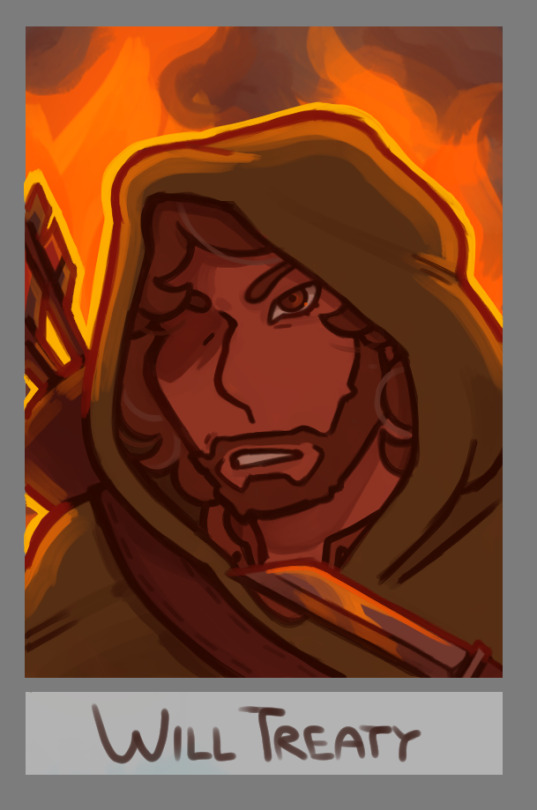
COMING IN WITH THE STEEL CHAIR IT'S WILL TREATY
He is on my mind, always. I don't talk about him as much but he's probably still the fictional character who had the most impact on me as a person.
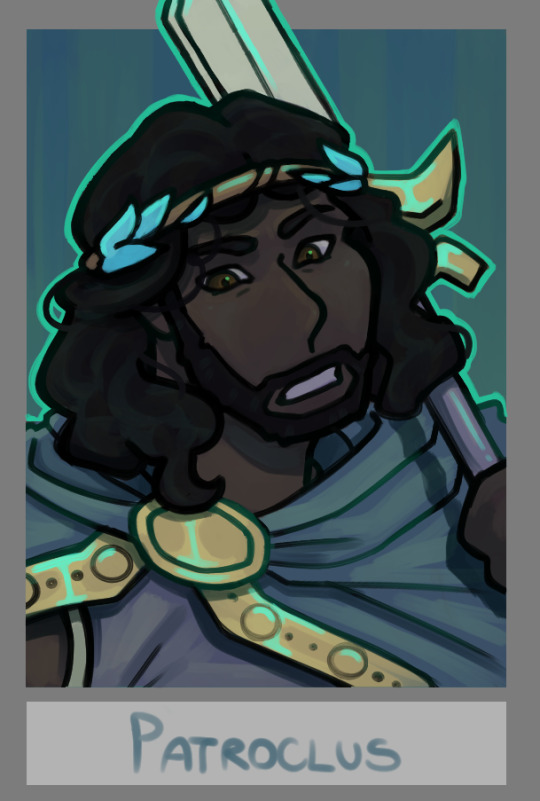
PATROCLUS! PATROCLUS!!! SIR I'M YOUR NUMBER ONE FAN!!
I got into patrochilles and the Illiad in general thanks to "The Song of Achilles". It was one of the first queer books I got to have in real life and the prose captivated me instantly, I still have it on my shelf. After reading the Illiad itself however, I hate that book so much. I'm sorry it's genuinely beautiful and I get why people like it but I can never forgive that horrible Patroclus characterization after seeing what he was originally like. Achilles too for that matter.
Hades swooped me up into its arms like I was a sick baby bird and nursed me back to health with its portrayal of the two though and for that I am forever grateful. I can't wait for Hades 2, death to Chronos.
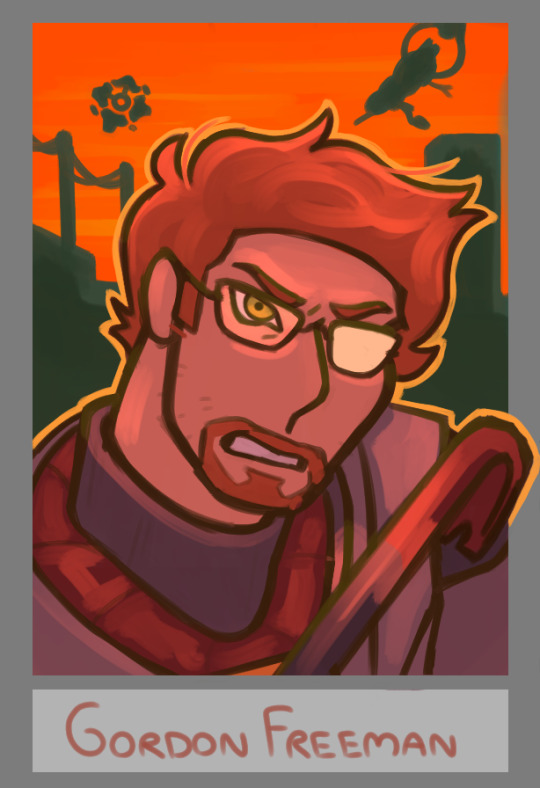
God Half-Life is such an important series for me. My dad would let me play through a few levels since I was a child, he grew up with the games, but I REALLY played through the entire series one summer shortly before dad moved out. He was there watching me play most of it and getting to enjoy someone actually translate the game's dialogue for him for the first time.
Gordon may not speak once but I like the hints of his personality we get throughout the games, most importantly from the way Alyx talks to/about him. I have my own characterization of him obviously but I do really think you can get a good understanding of the kind of man he is meant to be in-universe just by paying attention to his surroundings. Also another reason the games were so immersive for me is that I'm just as in love with Alyx as Gordon is. I must have let her get hit only once or twice the entire time just out of how protective I was over her. I'd topple the entire Combine empire just for her hand in marriage. I rewatched the ending of Half Life Alyx recently and cried.

I read the entirety of LOTR in one week in 11th grade, carrying that damn brick of a book everyday to school and back. I'm so glad I did honestly. Frodo and Sam are my important little guys and I find myself going back to them when I need something to calm me down in a way no other series except LOTR can. I've read most of Tolkien's work at this point, but nothing captivated me like those two little hobbits. Everytime I read a bad take about their relationship I sketch them making out.
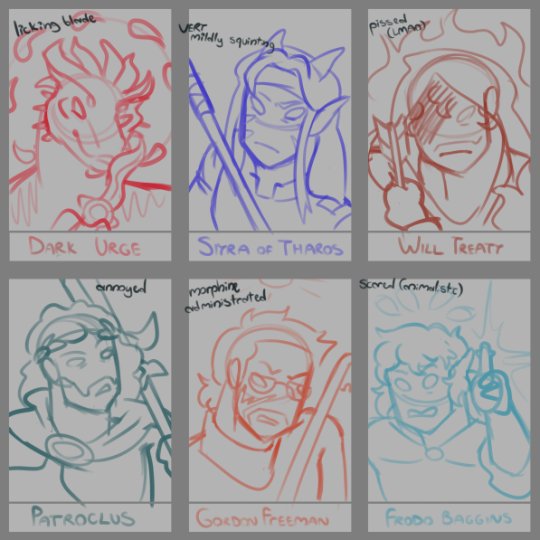
People liked seeing my drawing process before so here's the original sketch and the little notes I wrote to myself trying to set the mood. I followed like half of them.
#the dark urge#durge#will treaty#patroclus#gordon freeman#frodo baggins#default dragonborn durge#bg3#baldurs gate 3#rangers apprentice#the royal ranger#hades game#half life#half life 2#lotr#lord of the rings#🍃 fanart#that was a lot
54 notes
·
View notes
Text
The Last of the Animists: Exploring the Concept of Animism and How it Defines Nissa Revane
Prologue
Since the characterization of Nissa in the Kaladesh block is such a massive undertaking due to the density and quality of material therein, I decided at first to take a little break from my regularly scheduled programming (i.e. - having a public, frenzied, and unhinged obsession with my favorite Magic the Gathering character). However, I couldn’t stay away from the topic entirely, so here we are.
Introduction
The source of Nissa’s magic, its manifestation within Magic’s lore, and how it is represented mechanically on cards has intrigued me to no end over the years. Mechanically, I always felt that Nissa’s cards stood out more than the other two regularly-printed green planeswalkers (Garruk and Vivien). Garruk and Vivien cards often do what you would imagine a green planeswalker would do: create 3/3 green beast creature tokens, tutor creatures from your library, give overrun effects to your board, etc. The design space across these two characters’ cards always felt limited and uninspired to me. One of the things that intrigued me about Nissa, Worldwaker (read about my love for that card here) when I first encountered it in 2014 was the fact that it played around with lands rather than creatures: it animated lands into beaters, it untapped lands, it fetched lands from its owner’s library. This struck me as a unique, inspired design at the time, and it made me feel excited to use the card.
However, while yes, I have always found Nissa’s skillset a unique design for green planeswalkers – a fact that makes the desparkening all that much more disappointing to me – my primary interest in Nissa’s magic as a deranged Vorthos is how it is described in and displayed throughout the stories.
Nissa, as we are often told in post-“Nissa, Worldwaker” stories, is the last of the animists, a rare type of mage on Zendikar who can hear the voice of the world itself, but the plane of Zendikar rarely had anything nice to say; in “Nissa's Origin: Home,” Nissa’s mother, Meroe says that the soul of the land, which so often is a source of terrible nightmares for Nissa, “was never after anything other than random destruction.” Animism, we learn, is a taboo brand of magic to the Joraga (the tribe Nissa belongs to), and Numa, the Joraga chieftain, exiles Nissa because he, like many others, believes that the inherent anger of the land is due to some untold, unknown blasphemy enacted on the world by the animists. He tells Meroe, “[y]our people angered Zendikar and they paid the price. There is a reason that you are the last of the animists.” We come to understand that the reason for the plane of Zendikar’s anger is due to the Eldrazi Titans’ imprisonment on it. The world recoils in disgust at the eldritch monstrosities who eternally strive to break free of their imprisonment and consume and pervert every living thing in their way; the plane’s anger feels justified in this light, but almost no one on Zendikar understands this, not even Nissa or her mother.
So in short, animism in Magic the Gathering is the ability to connect with the soul of the world itself which allows animists like Nissa to (among other things) animate the land itself into living creatures that can fight alongside them.
However, the concept of animism has meaning beyond the lore of Magic; why did Magic’s designers label Nissa’s powers this way, and how can a real world understanding of animism help us understand Nissa in a new way?
Part I: The Animation of All Nature
Animism is a term developed all the way back in the 1870’s by British anthropologist Sir Edward Tylor as a method to describe similarities in “primitive” religions. Let’s take a quick moment to acknowledge that Tylor was a bearded white man living in colonial-era Britain using words like “primitive” to describe the religions and philosophies of people he will never meet, many of whom were currently unwilling subjects of his own government. This is an unfortunate commonality in academic studies. That aside, Tylor’s description of animism gives us our first understanding of this term. He writes in his 1871 anthropological treatise Primitive Culture that “[f]irst and foremost among the causes which transfigure into myths the facts of daily experience, is the belief in the animation of all nature, rising at its highest pitch to personification” (emphasis mine). In other, simpler words, animists personify the natural world, assigning traditionally human traits to immobile objects. The root of the current English word animate, after all, comes from the Latin animus, which means “soul, spirit, mind.” The “animation of all nature,” then, refers to the belief that what we might call objects of the natural world have their own interiority. Tylor writes elsewhere that animism is
[a]n idea of pervading life and will in nature far outside modern limits, a belief in personal souls animating even what we call inanimate bodies, a theory of transmigration of souls as well in life as after death, a sense of crowds of spiritual beings sometimes flitting through the air, but sometimes also inhabiting trees and rocks and waterfalls, and so lending their own personality to such material objects.
Humanity’s relationship to nature, then, becomes that of subject-subject rather than that of subject-object.
What does this say about Nissa, though? If you’re thinking that the above description is frighteningly similar to how Nissa views the world, you’d be right. While what Tylor argued back in the 1870’s was that animism is a crude belief system that would eventually evolve to the rise of world religions and later on the rejection of religion in rational society, Nissa’s practice of animism is very much alive and vibrant. It is hammered home often that Nissa deeply respects the personhood of objects, whether they be trees, animals, or even the ground itself. We see this very clearly in this long selection from the beginning of the Battle for Zendikar story “The Silent Cry”:
Every day there was something new, something Zendikar taught Nissa that surprised and delighted her. The land had hundreds of magnificent secrets, and it was sharing them with her.
She would never have guessed that the giant mantises secreted a scent meant to simulate the odor of fresh worms and thus attract small song birds—but not for the mantises to prey on, rather for the purpose of enjoying the birds' melodies. The songs were one of the few things capable of lulling the mantises into an easy sleep.
Nor would she have known that the vines draped between the close-growing, towering heart trees of the Vastwood Forest were more like arms than vines—arms that were holding hands. Each vine grew out of the trunks of two trees; it did not belong to one tree more than the other, it was shared equally between them, a tether that bound the trees. The vines connected one heart tree with its chosen companion, and allowed the two to share memories, feelings, and dreams.
These trees were linked forever; they mated for life.
And the gnarlids, the silly, beastly, sneaky gnarlids; they had a ritual that they managed to keep hidden from most everyone else on Zendikar. On the darkest nights, when there was no moon but the skies were clear, the gnarlids scaled the tallest trees, poking their heads above the canopies, and they laughed at the stars. Little breathy snickers that to anyone else listening sounded like nothing more than the leaves of the highest branches rustling in the wind. It was an inside joke meant only for them.
Equally as impressive was the tribe of humans who lived in the lowest canopy of the Vastwood's trees—not in a central encampment, but spread out through the expanse of the forest. Five or six humans shared each treehouse hamlet, and there were over a dozen hamlets. The tribe was able to stay well informed of each other's movements and needs thanks to their ancestors, who had closely studied the language of the chatter sloths. The people sent messages to each other by speaking to the nearest chatter sloth. It was only a matter of minutes before the sloth would relate the gossip to its neighbors, who would pass it along through the network of tree dwellers. Soon all humans in the tribe would know of the hamlet's news thanks to the little gossipmongers.
It’s important here that Nissa shares equal amazement with the goings on of plants and animals as she does with the ingenuity of her fellow sentient mortals; to her, they are no different. To Nissa, the “animation of all nature” is not some crude, outdated philosophy that has been surpassed by rationality. It is her everyday reality.
Of course, however, Magic the Gathering is a game of wizards battling each other, and its worlds and characters are full of wonder and, well, magic. The “animation of all nature” has another meaning to Nissa in that she can call out to the interior soul of immobile objects and, in a non-metaphorical way, personify them … as in, she can “animate” objects into living, walking, thinking, fighting creatures with a will of their own. In the first story of the Zendikar Rising arc, “In the Heart of the Skyclave,” Nissa and Nahiri, looking for a specific object of interest, are at a loss at which place to begin hunting for it in a giant, city-sized airborne dungeon when Nissa spots a lone fern:
Nissa crouched down to one of the ferns. Its leaves were as large as she was, but its flowers were tiny, delicate, and blue.
"How is it possible for plants to thrive here?" Nahiri asked, coming up behind her.
Nissa smiled. "You'd be surprised at how many things thrive in unlikely places on this plane."
"How—"
Nahiri began to speak again, but Nissa tuned her out. She rested a hand on the top of the fern, like a parent's hand on the head of a child. She closed her eyes and felt its life under her fingers, felt its struggle and its pride in surviving in such a foreboding place. Nissa smiled at that strength and that pride. And she called it forth.
She heard Nahiri give a gasp as the elemental emerged into existence. It was a tall thing, twice her height, green and vibrant as its life force, its head a mass of fronds with small chains of blue flowers entwining its arms and neck.
The dual meaning of the “animation of all nature” is on display here. Nissa very clearly acknowledges the personhood of the fern, using terms usually reserved for descriptions of the lives of people like struggle and pride, and at the same time she animates the stationary fern into a creature, a person with a will of its own and strength to match. In the end, many elements of the Zendikar Rising arc were lacking, but I always found this particular scene to be a wonderful marriage of the best parts of Magic story: great character moments tied together with a childlike wonder at the beauty and power of magic.
Part II: Infinite Possibilities
Anthropology, however, has moved far beyond its Victorian, colonialist roots. On the same note, Nissa has grown and expanded far beyond the borders of what she previously was.
In 2006, anthropologist Tim Ingold published an essay titled Rethinking the Animate, Re-Animating Thought that reevaluates the concept of animism (there are, of course, many evolutionary steps between the philosophies of 1871 and those of 2006, but for the purposes of this piece, suffice it to say that things have changed). Ingold’s primary thesis is that animism should be considered less of a primitive branch of religious thought and more of an ontological philosophy, an experience of being present in the world. In his research, Ingold provides this anecdote:
One man from among the Wemindji Cree, native hunters of northern Canada, offered the following meaning to the ethnographer Colin Scott. Life, he said, is ‘continuous birth.’ I want to nail that to my door! It goes to the heart of the matter. To elaborate: life in the animic ontology is not an emanation but a generation of being, in a world that is not pre-ordained but incipient, forever on the verge of the actual. One is continually present as witness to that moment, always moving like the crest of a wave, at which the world is about to disclose itself for what it is.
This is a lot to unpack, but let’s use this to point out the similarities and differences between the previous 1871 understanding of animism. Like Tylor’s initial exploration of the concept, Ingold’s animists still treat the world around them with same respect and reverence; they still, in other words, still interact with the world with a subject-subject relationship instead of a more rational subject-object relationship. However, instead of fixating on the spiritual aspects of animism (i.e. - the inherent soul of inanimate objects), this modern take is more of a state of being, a practice of actively engaging with the world around you.
Ingold, in other places, argues that, while yes, animism intentionally blurs the line between what is considered ‘alive’ and what is not, the true cornerstone of an animist ontology is the process of change:
Wherever there is life there is movement … The movement of life is specifically of becoming rather than being, of renewal along a path rather than displacement in space. Every creature, as it ‘issues forth’ and trails behind, moves in its characteristic way. The sun is alive because of the way it moves through the firmament, but so too are the trees because of the particular ways their boughs sway or their leaves flutter in the wind, and because of the sounds they make in doing so.
An animist, then, in this ontology is in a responsive, conversational relationship with the world around them. They wouldn’t fixate, for example, on the personhood of a tree, but they would know how to have a positive, symbiotic relationship with the tree.
What does this new way of looking at animism have to do with Nissa Revane, though? It seemed like Tylor’s outdated definition of animism already had both Nissa’s worldview and the manifestation of her magic pegged down. What could be added? Well, like the definition of animism, like this “world that is not pre-ordained but incipient, forever on the verge of the actual,” Nissa herself has changed drastically in recent years.
If I had the time and bandwidth, I might set out to argue that, of all Magic’s heroes in the last decade, Nissa has gone through the most character growth of any of them; she has shifted through the most colors and she has gone through the most development of any other planeswalker. However, for the purposes of this piece, I’m going to focus on the most recent story (to date) that Nissa has appeared in: Grace P. Fong’s “She Who Breaks the World.” Now, I’ve made it no secret that this is my favorite piece of Magic fiction since the Ixalan days, so I’m certainly biased here, but the narrative meat in this text is rich and vibrant.
When we pick back up with Nissa in “She Who Breaks the World,” we find her at likely the lowest point we have ever seen her at. Her agonies are manyfold at this point. To start, she is still reeling from the unbearable trauma of what the Phyrexians did to her. She had set out with a strike team of her planeswalker allies to stop the Phyrexian invasion of the multiverse, but upon their failure, Nissa, along with many of the others, were captured. Her mind was chemically altered against her will to be utterly, completely submissive to the will of Elesh Norn (the Phyrexian leader, if this essay somehow reaches beyond the MTG sphere). Similarly, her body (again, against her will) was then chemically and mechanically altered to be more in line with the Phyrexian understanding of perfection. Then, Norn used Nissa’s body, mind, and animist powers to launch an invasion of the entire multiverse; Nissa ended up being instrumental in this process because it was her animist abilities that allowed Norn to directly control the Invasion Tree.
Nissa was eventually freed from the Phyrexians’ control in the aftermath of the war, her mind given back to her, and as much of the grafted metal removed from her body as could safely be removed. However, no level of healing could “cleanse the memories of what she had done” while her mind was under the domination of Phyrexia. She understandably has trouble forgiving herself for what she did, whether she had agency in the act or not.
Secondly, if that wasn’t bad enough, after she woke up with her mind intact, she discovered that she had lost her planeswalker spark. While she is not alone in this (all of the other planeswalkers currently on Zhalfir aside from Chandra lost theirs as well), it hits Nissa particularly hard because, for one Nissa has always had a deep connection to her home world of Zendikar, and secondly, Zhalfir is full of people she tried to ruthlessly kill while under the influence of Phyrexia. She cut down in cold blood dozens, if not hundreds, of these survivors’ friends and family. While the surviving Mirrans and Zhalfrins understand that she did not have control of herself during this time and forgave her, Nissa does not feel incredibly comfortable living around people she so directly harmed. She is restlessly homesick with no feasible way to get home and stuck with people she doesn’t feel worthy enough to be around. Furthermore, Nissa’s planeswalker powers are integral to the identity she has created for herself. This sense of self is just one more thing she has lost.
And lastly, there is the issue with Chandra. While they were technically a romantic couple after they kissed at the end of the previous March of the Machines story, “The Rhythms of Life,” things are still far from well between them. Apart from the tremendous guilt and shame Nissa feels from what she did to Chandra during the Phyrexian story arc (Nissa almost killed Chandra multiple times, one time even impaling her), both of them are still dealing with the fallout of their breakup as described in War of the Spark: Forsaken (even typing the name of that book makes me feel ill). Nissa wonders if Chandra can ever love her the way she needs and if that is even a reasonable thing to ask of her after all the two of them have recently gone through.
While this was a long, drawn-out summary, I think it was necessary to show what Nissa is going through on the cusp of her metamorphosis. The depression she is feeling along with what could probably be described as PTSD has left her stuck in the past. She laments the fact that she no longer hears the voice of nature. The leyline songs are completely silent, and when she calls out to the soul she knows dwells in all the objects in the world around her, nothing answers. She assumes this is punishment for what the Phyrexians made her do.
She’s wrong, however. Nissa and Chandra finally have a moment of understanding between the two of them, and as a part of this intimate moment, Nissa finally admits that her animist power no longer work; when Chandra expresses surprise at this, Nissa responds,
"They won't listen to me. I tried. Many times. But when I call out to them, it's like my voice isn't my own. Like it belongs to Phyrexia instead, like everything I've ever connected to is drowning me out."
For once, Chandra pauses. "You know," she concludes. "You have good connections, too."
"What do you mean?"
"It's true—you did bad things while they had you. But everyone you've connected with over the years with the Gatewatch, we're just happy you're still here. With us." Chandra sets fire to a chunk of moist dirt that was about to fall on Nissa, turning it into a soft rain of ash. "With me."
For the first time since she awoke in Zhalfir, Nissa smiles. Chandra, sweet Chandra, even if she doesn't realize it, has always understood and explained emotions better than Nissa ever could.
Chandra continues, "Your connections aren't drowning your voice, Nissa. They're changing it into something new, maybe something even more powerful. Infinite voices, infinite possibilities, right?"
Infinite possibilities. Nissa offers her hand to Chandra. "All right, let's try."
Gripping Chandra's fingers in hers, Nissa closes her eyes. She retreats inward and listens for her inner voice. It's hard, much harder than before, but Chandra is dutifully helping her concentrate, blasting the falling rock away before it can reach her.
Nissa is greeted by ringing deep in her ears, but she refuses to be deterred. With her connections in mind, she picks the static apart into unique melodies, the individual songs she picked up from all around the Multiverse. She arranges them, harmonizes them, and this time, when she calls to Zhalfir, her voice is amplified in chorus. She offers an apology.
The plane answers. It too was cut off from everything it knew, from the connections it had made. It, too, was scarred by Phyrexia and is growing into something new. It forgives her, and Nissa can finally forgive herself.
Magic floods her flesh, her blood, her bone. She hears Chandra laugh, delighted by their success.
I could literally talk forever about this scene, how it is also a marriage of everything I love about Magic Story, but let’s zero in on how Nissa’s change in perspective is similar to how animism has changed meanings over the past one-hundred and fifty years.
In the same way that Tylor was fixated on how “primitive” he felt animism was, how it was just a cultural stepping stone on the way to enlightenment, Nissa remained fixated on her animist powers. To her, the voices of the natural world were oftentimes more real to her than the voices of her friends. The songs of the leylines, the elementals she could animate with a whisper, the power she wielded in defense of the worldsoul … To Nissa, these were all in all.
However, what Nissa learns from Chandra in the climax of “She Who Breaks the World'' is to accept that life is exactly what Ingold calls a “continuous birth.” Nissa embraces this conversational relationship with the world around her, and nature is no longer all in all to her. Hand in hand with Chandra, Nissa now lives “in a world that is not pre-ordained but incipient, forever on the verge of the actual,” as Ingold puts it, and a world of “infinite possibilities,” as Fong puts it.
As the definition of real-world animism has shifted over the years, so too has Nissa’s magical animism. She used to obsess over her connection with nature with religious fervor, and even though Nissa worshiped no gods, her devotion to the soul of the world around her was stronger than many devout worshippers on Theros. However, in “She Who Breaks the World,” Nissa learns to recognize that she, and the rest of the world around her, is alive because she moves in her own “characteristic way.”
Epilogue
While I have certainly been burned by WotC’s treatment of Nissa in the past, I am cautiously excited for the stories that can now be told about her. Nissa is currently set up to grow and expand in interesting ways, and I hope (beyond hope) that future Magic stories starring Nissa will continue on the path that Fong set her on.
Nissa may be the last of the animists, but that doesn’t mean she can’t be the first of something else. I’m excited to see what that “something else” will be.
Bibliography
Every source quoted in this essay is linked directly before the quote in question. I was too lazy to create a reference page today. Sorry! 😬
74 notes
·
View notes
Text

@gothic1hop My friend take a second to imagine watching that for the first time when you're 10-ish. IDK how much context you have for your first watch, but keep in mind that we had no idea about IK and Marcy having anything to do with each other at that point. We'd only seen Simon once before from the tapes in Holly Jolly Secrets, which was the bombshell drop that Ooo used to be roughly parallel to our world. And with that one exception IK was primarily a comic relief or a villain-of-the-week for like 3 years in real time. He was mostly a nuisance with the occasional fun episode, and Marceline was cool but the only real characterization we had was that she was a rebellious teen-adjacent being with demonic dad issues. In the span of a single song the entire understanding we had of those two was completely flipped.
(ok honestly I'm just using this response ((thank you for the response + update btw)) as an excuse to ramble about how much I love this episode so I'm gonna list some stuff out.)
This episode recontextualized:
-Everything we knew about Simon. He wasn't isolated until he went insane, he had relationships with other people in the world after the rubble came down, relationships he is now incapable of remembering.
-Basically everything we knew about Marceline and her family. She was not raised by Hunson Abadeer, at least not in early childhood. She grew up in the ruins of Earth.
-The events of Memory of a Memory. Ash broke a lot of boundaries, but suddenly Marcy's intense rage at specifically losing Hambo makes a lot more sense.
-The design of Hambo. He's not something Marcy found tucked away, or something made hastily without much attention. This thing has been around for a thousand years, lovingly tended to throughout the ages. He's not messy, he's extremely well-used.
-The Crown and Simon's lifespan. It was already implied in Holly Jolly Secrets + other bits of dialogue throughout the previous seasons that the IK was really old. Now we have a rough timeline. We learn the minimum age that Simon was when he met Marcy later, but combined with Marcy's current age we know that he's at least 1000. Given that we know Simon was once a normal human, this gives us some interesting info about the Crown.
So anyways to sum up my point

55 notes
·
View notes
Text
I love both John and Arthur
“RDR1 Represents John’s Character Growth” Argument…
I’ve seen people get blocked for disagreeing with the types of posts that complain about “Rdr fans disliking John’s characterization in rdr2”. I’d rather just agree to disagree but if anyone doesn’t like where this post is going, please feel free to use the block button.
Also, in this post, I am repeating some things I’ve written in past responses/posts. Plus I have read other fans’ posts and opinions about this topic, which will be sprinkled throughout this post.
Here it goes… Mainly for me, it’s the ret-con. It’s not that John can’t be this man with flaws, but in the first game (rdr1) they hint a lot at John (when he’d been in the gang in the past tense, before the events in rdr2) being this quixotic, well-spoken, “right-hand man of Dutch”, which were traits that were all given to Arthur in rdr2. Even Bill and Abigail hint at this. If you want to hear another rdr fan go more in-depth about this, read here. Plus Rockstar in so many words had explained why they made John a humiliation conga because they didn’t want John to “overshadow” Arthur.
Yes, Arthur is older and yes, John could’ve been influenced by Arthur (but only by so much, I mean, c’mon John and Arthur are their own person). Yet the fact that Arthur is not even mentioned in rdr1 (yes, rdr2 hadn’t even been created yet. I know.) and they decided to “downgrade” John in rdr2 and give all of these admirable traits (they allude to in rdr1 about John) to Arthur is what baffles me.
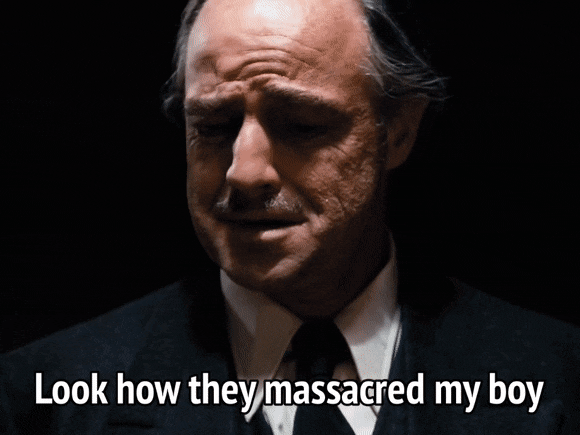
Don’t get me wrong, I LOVE Arthur’s character. However, it’s the high pedestal that this fandom puts him on, emphasizing his positive traits while continually bashing John in the process, that does me in.
We get it, John wasn’t a good father or a good husband, he treats his wife and kid like crap (he gets better tho), he deserves whatever criticism he gets for those horrible actions of his, but we got to remember this is the Wild West; Abigail nor John had the resources or skills to deal with their own trauma much less even raise a boy in a gang, especially Abigail. But that’s not downplaying the fact that John is a very emotionally-mentally damaged person (as a result of many forms of abuse and being raised by Dutch, Hosea, and Arthur, who aren’t the best examples) while at the same time, Abigail is a very emotionally-mentally damaged person (as a result of many forms of abuse and being raised and working in a brothel) who’s had to carry a kid for 9 months and march on through with barely having much help, aside from some individuals in the gang who helped her—I’m not gonna go with the narrative that not a single person in the gang helped.
Listen, it’s not that we can’t handle seeing John being this pathetic version of himself that the devs chose to portray him as in rdr2 (so he wouldn’t overshadow Arthur and lazy writing) or that we can’t watch him grow from this immature and flawed human being to a man who loves his wife and child and would do anything for them… but it’s how it was done and how rockstar did it.
They also did Johnny boy’s physical character design very poorly in the epilogue; in the epilogue (1907) he barely showcases any of the traits we see in (1911) rdr1 (a four-year difference, timeline-wise, which really isn’t that long). Although NPC John and Epilogue John might look different from each other, their personalities aren’t much different. So there’s not much of a change in my opinion.

Also, I just want to clarify that this post isn’t about the fandom preferring Arthur over John but more so about how John’s characterization was done in rdr2 compared to rdr1, which can’t merely be attributed to “character growth” rather than lazy writing. Understandably, many people prefer Arthur over John. Hence compared to the first game, rdr2 has better accessibility, players get to go more into the protagonist’s mind, and many game mechanics have improved/developed since rdr1 was released. But rdr1 was an acclaimed game when it came out with many fans that still remain in this fandom, in spite of rdr2’s wider exposure.
And if I was going to mention anything that the games were kind of consistent with when it came to John’s characterization, is that he has a dry and cynical personality that reflects the protagonists of old spaghetti westerns, and the unforgiving world that makes up the Wild West.
Personally, while I do like his character in both games (he’s my fave) I still feel like there’s a bit more they could’ve done with his character in rdr2, in regards to missions and stuff, I would even say the devs had put more effort into some supporting characters compared to John, but that’s just my opinion. And I was really hoping for a rdr1 remaster but more so in a Yakuza Kiwami way (amped-up gameplay, fixed plot holes, better character detail, quality improvements, etc…)
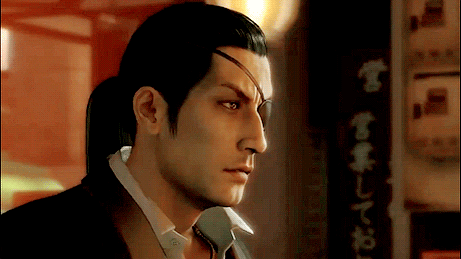
#rdr2#john marston#rdr2 community#rdr2 fandom#rdr2 john#arthur morgan#red dead redemption 2#rdr#dutch van der linde#jack marston#rockstar is lazy#rockstar#john marston is the og#john marston deserves better#john marshall
50 notes
·
View notes
Text
“A Wonderful Experience”: Why Transformers: EarthSpark and Nightshade Matter

I’ve been a Transformers fan to one degree or another for as long as I can remember. Whether it’s early memories of watching Beast Wars, renting the G1 animated film on VHS from Blockbuster, or reading the numerous excellent comics that have come over the years, I’ve always found something to love about this franchise. So, I was probably going to find time to check out the 2022 CGI animated series Transformers: EarthSpark eventually no matter what. But one little bird changed that from an “I’ll get around to it eventually” to “I need to make watching this show a priority.”
A little bird by the name of Nightshade (voiced by Z Infante)!

I’d already heard from people I trust about EarthSpark’s quality as a series, but finding out about the franchise’s first prominent, explicitly nonbinary Transformer got me eager to dive in. I’ve discussed characters I relate to and read nonbinary themes into in the past, but getting a chance to see a show in a franchise I love feature that kind of representation with intent was exciting. Given the fact I’ve written 3000 words analyzing the character of Nightshade now, it’s easy to say I wasn’t disappointed!
The topic of gender and how it relates to the Transformers as characters has been one of many long, exhausting fandom debates over the franchise’s nearly four decade history. I’m not here to relitigate any of that, so take it as read from here on out that the Transformers as characters do have and express gendered identities throughout the history of all its incarnations.
To give a quick primer on EarthSpark as a whole (and why it’s great) before digging into Nightshade’s character in specific:
The series is set fifteen years after the end of the Autobot/Decepticon War. The bots that managed to survive the fighting and remain on Earth are presumed to be the last of their species. All of them are stuck in a holding pattern where the only options currently viable are a life in hiding or working alongside the government-funded alien threat detection/response agency GHOST. Optimus Prime and Megatron head up the latter efforts, in the hope of finding some peaceful balance between humans and Transformers going into the future (though neither of them are fully at ease with the situation, as GHOST clearly has ulterior motives of their own.)
The grim outlook for the Cybertronians takes a turn for the better with the birth of two new Transformers. The Earth-sparks of the show’s title (called “Terrans” throughout the series), Twitch and Thrash, who are bonded to the human children Robby and Mo Malto. Helped by Optimus, Megatron, and the Malto kids’ parents, GHOST agent Dot and her husband Alex, the decision is made to keep the Terrans a secret until the extent of what their existence could mean for the Transformers future as a species is fully understood. The Terrans become an official part of the Malto Family (lovingly referred to as “Malto-bots” by the other characters.) At the halfway point of the first season, in the episode “Age of Evolution”, this unconventional family unit expands further with the birth of three more Terrans, including Nightshade.
Between puzzling out the Terrans’ existence, hiding from GHOST, and fighting threats like the human mad scientist Mandroid, there’s a lot of thematic meat on the bone of this series’ setup. The main one I’m interested in digging into through the lens of Nightshade’s characterization is how the Terrans are written to feel like kids figuring out who they want to be as they grow up. Transformers has a history of designating one or more bots in its series central casts as the rookie/kid character, not insignificantly the Terrans’ primary mentor, Bumblebee, has been traditionally positioned as that very rookie. EarthSpark adding the narrative weight of representing a potential for all Transformers, particularly in how they’ll relate to humans while living on Earth, onto these characters gives more meaning to them being under that role.
The Terrans learn lessons about who they want to be and who they can/can’t trust (not always determined by old alliances like Autobot/Decepticon) from the older Transformers and humans alike. Also proving through their actions everything new they’ll have to offer the world they call home through the gift of their existence. Each Terran has been given the appropriate space so far to have their characters develop, each in their own directions, through this theme.
Nightshade is exemplary of this, best understood through looking at how they’re characterized before/after their first focus episode “Missed Connection”, about them forming a bond with Decepticon scientist Tarantulas.
[SPOILERS for EarthSpark beyond this point]
Before “Missed Connection”
Something that genuinely impressed me going back through EarthSpark for the sake of writing this piece is how immediately Nightshade is fully themself from their earliest bits of screentime in “Age of Evolution.” While the other two members of the second batch of Terran Transformers, Hashtag and Jawbreaker, have their names confirmed upon them by their connection to Robby and Mo, Nightshade actively introduces themself with a bow and a flourish (“It is a delight and a surprise to meet you all!”) This beat quickly establishes their self-assuredness in their identity and that, while they’re later shown to have occasional introverted tendencies, they are anything but shy. I’m also fond of how the scene establishing their pronouns as Optimus lays out their plan of attack also foreshadows their eventual alt-mode, since they ask to be represented by an owl-bobblehead during the planning. The one scene serving as a contrast to their outgoing demeanor, as they recoil at the sight of Mandroid’s cruelty, gives the first hint towards their eventual desire to protect those in need.
There’s only two episodes between Nightshade’s debut in “Age of Evolution” and their first focus episode; “Hashtag: Oops” and “Outtakes.” Since neither is their focus episode, there’s not much to say about how they’re portrayed in either one (in fact, Nightshade’s entirely absent from “Outtakes” as anything but a brief visual cameo.) “Hashtag: Oops” does still manage to establish some key parts of Nightshade’s personality. Firstly, their comfort in themselves as they proclaim they don’t need an alt-mode (“I like who I am as I am.”) Secondly, their inclination towards tech and engineering as they secretly build a new underground base to surprise their family and give everyone more room to operate within. The latter also indicates their “better to ask forgiveness than permission” approach to their tinkering and scientific work. Which comes back around in a big way during “Missed Connection.”
Which finally brings us to the episode that’s the primary reason I’m writing this piece at all!
“Missed Connection”
Being Nightshade’s first proper focus episode in the series, their current state as part of the ensemble cast gets reestablished in short order. Namely, how they feel out of place around their siblings. Their affinity for science and technology leads to them making their own fun separate from the rest of the family. A pattern that gets highlighted by Nightshade working to perfect a new training drone while the rest of their siblings are playing a game of tag outdoors in celebration of Robby and Mo having the day off school. When later questioned by Alex and Dot about why they don’t spend more time with the rest of the family, Nightshade says it feels like their siblings treat them like they’re “speaking another language.”
This sense of isolation informs why Nightshade is so eager later in the episode when they find a connection with Tarantulas’ own work with tech. Simultaneously providing an opportunity for Alex to offer them something they can connect with while trying to figure out how to connect with others. Like any good nerdy dad, he does it through the magic of reading. He offers Nightshade a copy of his favorite book from when he was growing up, “Winged Sentinel”, an in-universe fantasy/sci-fi series they immediately connect with and find new aspirations. Which we hear as they repeatedly call back to the books like about its hero “protecting those in need.” Their connection to this book quickly leads to the one they find working with Tarantulas, as they were in the local cemetery since it was the “last known address” of Winged Sentinel’s author.
(Quick aside: First time I watched this episode, that detail had me thinking the show was going to do a “Nightshade learns about mortality” type of story. I was relieved when not only did Nightshade grok what happened to the author pretty fast, but the episode in turn swiftly shifted to the dynamic between Tarantulas and them.)
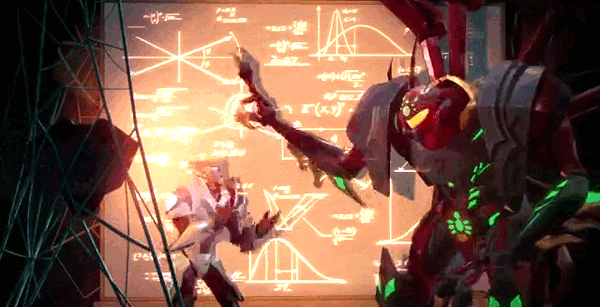
“Missed Connection” finds its central theme in Nightshade and Tarantulas’ discussions on identity and finding one’s place within that world rife with conflict that can be directly hostile to those like them. There’s a recurrent motif in the dialogue of Tarantulas’ cynicism born from eons of experience and Nightshade’s youthful enthusiasm. Though cynicism is far from all the elder Transformer has to offer, as he also provides Nightshade with a new perspective on alt-modes they hadn’t considered and ultimately guides them to their choice.
Nightshade: Aren’t I sufficient as I am?
Tarantulas: Alt-forms aren’t meant to complete you, as though you have a missing part, they further express who you already are.
Combining that with Tarantulas’ frustration at the “constrictive labels” of Autobot/Decepticon adds to the resonance this episode has with the nonbinary experience. The concept of “passing” gets explicitly evoked by him while discussing his plan to create a hard-light hologram projector so he can live freely as a human while evading GHOST’s forces. Which is the first proper disguise Tarantulas has taken in his life. While his giant spider alt-mode may provide plenty of utility, it’s anything but discreet.
His plan and attitude informing on it connects back to the broader central theme of EarthSpark as a series of the Transformers finding a new way to live on Earth among humanity with the Terrans representing the way forward. He can’t see a way forward besides hiding who he is and the only safety he can think to offer Nightshade is to join him in that life of discretion. His outlook’s best emphasized by his assuredness that the Autobot/Decepticon War resuming is inevitable, alongside that eventuality dragging him out of whatever peace he does find.
However, cracks in Tarantulas’ bleak worldview show as he begins to admire Nightshade’s exuberant demeanor and determination to be a protector. That admiration for a Transformer with the potential to live unburdened by all the hardships he’s seen leads to him delivering the best, most resonant line in the episode:
“It is a gift to know yourself so well, so young. Take pride in that.”
A beautiful sentiment aimed directly at members of EarthSpark’s target demographic on their own journeys to express their identities.
Unfortunately, the bond these characters have found can’t last. When Tarantulas recognizes Dot as an agent of GHOST, he acts rashly under the assumption that she’s holding Nightshade prisoner. He kidnaps Alex and her, planning to erase Nightshade from their memories so they can go into hiding with him. As a fight between the bots eventually breaks out, Nightshade commits to acting like the protector they aspire to be and chooses the alt-mode of a green armored owl, based on the hero of Winged Sentinel. (Alex’s proud declaration of “You read the book!” while witnessing this is great.) A form that isn’t a disguise but expresses themself as they are and what they want to be going forward.
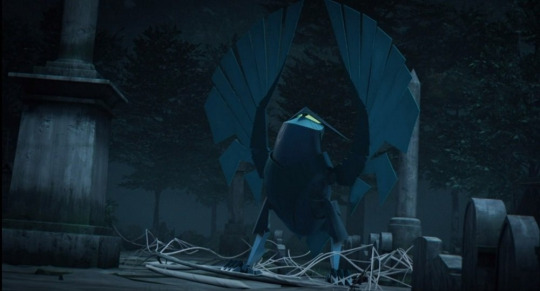
Nightshade and Tarantulas’ conflict has grown intense enough by this point that the elder Transformer’s admiration for the young bot doesn’t come through in his reaction. Rather he flips it into an insult providing Nightshade their opportunity for a sharp, direct retort (and other best line in the episode):
Tarantulas: You’re still just the lost protoform I first met!
Nightshade: You’ve just proven you don’t really know me, because I was never lost!
When the fight ends with Tarantulas’ hologram projector destroyed in the skirmish, Nightshade reflects on words Dot offered them earlier about how everyone deserves a second chance and convinces their family not to hurt Tarantulas any further. However, it seems to be a decision out of their hands as GHOST is drawn to their location by the fight. Tarantulas, finally understanding Nightshade’s situation as well as who they are, offers himself up as bait to lure GHOST away from the Maltos. Running off into the forest as Nightshade reflects on the broken hologram projector the two of them made.
Multiple rewatches of this episode, as well as the first season of EarthSpark as a whole, has reaffirmed it as my favorite episode of the show so far. The tight focus of the dynamic between Nightshade and Tarantulas, alongside the deeper meaning that can be taken from pretty much every exchange between the two, is exemplary of what makes this series standout wonderfully as part of the vast Transformers canon.
After “Missed Connection”
Since there’s not that much of the first season left after “Missed Connection”, Nightshade’s once again mostly off to the side doing their own thing. But there are small bits that show how their experiences in that episode have changed them. They actively spend more time around the rest of the Malto Family, like helping Bumblebee train for an upcoming race and showing that they’ve formed a bond built on mutual tech-obsession with their sister, Hashtag, as they work together to further upgrade the underground headquarters.
We also get a fun minor bit of their “better to ask forgiveness…” way of operating when they add some high tech bells and whistles to Dot’s prosthetic leg as a Mother’s Day present in the episode “Bear Necessities.” A plot point that later gives the show an opportunity for Dot and Nightshade to have a nice mother-child bonding moment as she explains to them why she liked her leg the way it was in terms they can understand (“something like this is personal”) while not completely shutting them down over it (“I’m open to some small changes, but they’ll have to be ones we come up with together.”)
Though the biggest moment post “Missed Connection” moment for the character, as well as my personal favorite single scene in EarthSpark so far, comes from their subplot in the season 1 two-parter episode “Home.” As the Malto kids and the Terrans go into Philadelphia to see more of the wider world, we get to see Nightshade continue acting as a protector for those in need as they save a young person named Sam from getting mugged in an alley. Nightshade notices a pin that says “SHE/THEY” on Sam’s handbag and tells her their pronouns in return. The two end up having a conversation about how the things that make them who they are can also make them targets for intolerantly minded people. This interaction ends with Sam affirming they feel safe around Nightshade and giving the young Transformer a simple but effective explanation of what being nonbinary means.

This not only gives Nightshade further context to understand themself, but also has the important touch from a metaperspective of having a human character be the one to explain the concept. An effective dodge of what’s frequently cited as a pitfall of using aliens/robots to explore these facets of human identity, making it as clear as possible for anyone watching (especially the target demographic of kids) that Nightshade’s nonbinary identity is in no way just a product of their being an alien robot. Rather, it's an identity that simply feels right for some people living in the world. One that people who identify with it and explore their connections to it can find immensely fulfilling.
Or, as Nightshade puts it at the end of this conversation:
“What a wonderful word, for a wonderful experience.”
(Before I dive into my conclusion, I want to say I deeply hope this isn’t the last we see of Sam in the series. Both for representation’s sake and because I like seeing the Terrans bond with humans outside of their immediate family circle.)
It would feel wrong to end this look at Nightshade’s character and how that reflects on the best qualities of EarthSpark as a series without giving proper credit to the creative voices involved in bringing them to life. Namely, writer Mae Catt (she/they) who wrote the episode “Missed Connection” and one of the three writers on “Home”, the other two being showrunners Nicole Dubuc and Dale Malinkowski. While fundamentally I believe anyone could write any kind of story, authenticity comes through stronger when writers from the same background are involved. Catt’s passion for writing this show comes through beautifully in these episodes and in how they’ve discussed the show on social media.
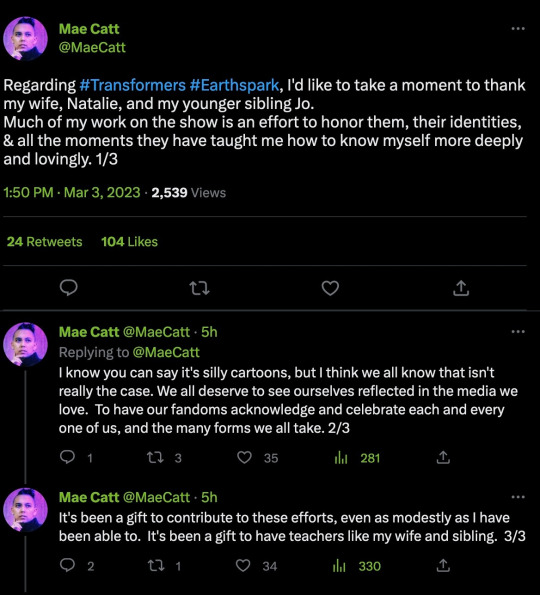
Her understanding for what these characters and stories can mean to the young people watching gets clearly reflected in recurrent elements of EarthSpark’s story. Aside from Nightshade’s admiration for the main character of the Winged Sentinel novels, we also see moments in other episodes of their siblings trying to figure out what being a Transformers means through in-universe Transformers comic books telling the story of the Autobot/Decepticon War.
It’s also what drove me to write this piece. I see Nightshade in all their creative, expressive glory and it makes me happy for the kids watching Transformers: EarthSpark, seeing them, and relating to them. Every story has the potential to be a guide someone out there can use to move closer to their heart. Nightshade’s being that guide to nonbinary kids now in a way I never could’ve dreamed of growing up is, simply put, wonderful.
Happy Pride! 💛🤍💜🖤
If you like what you’ve read here, please like/reblog or share elsewhere online, follow me on Twitter (@WC_WIT), and consider throwing some support my way at either Ko-Fi.com or Patreon.com at the extension “/witswriting”
#transformers earthspark#transformers#nightshade#nightshade earthspark#Wit's Writing#tv review#nonbinary#lgbtqia#queer#nightshade malto#nightshade transformers#pride#happy pride
108 notes
·
View notes
Note
gotta send Ryoji Mochizuki
Thanks for the ask! Hope your day's going well, fellow Ryoji enjoyer.
Spoilers below for P2, P3, P4, and P5R.
Send me one of these here!
First, I want to give some thoughts on his character as a whole. For the certain type of character he is (doomed, remorseful harbinger), Ryoji Mochizuki is perfect. I don't think there's a better Persona twist than his reveal as the the Appriser/Death, the thirteenth Arcana Shadow. Just because a twist is easy to see coming doesn't make it less impactful, and I particularly enjoy the way Persona 3 distills information to the player in allotments. Even knowing that, Ryoji managed to surprise me with how much more he was. And fittingly, a lot of Ryoji's characterization bounces back to the P3 Hero, and vice versa.
On top of that, Nyx Avatar is my favorite final boss in the entire Persona series and unsettled me out the first time. I'd still say that Nyx Avatar causes me more fear than the Reaper, who I'd comparatively describe as inciting panic rather than fear.
Ryoji is frequently compared to Kaworu from Neon Genesis Evangelion (NGE), and, well. Yeah. I believe I read that in a developer interview that the P3 dev team deliberately took inspiration from NGE but I'm unable to find a source at hand, so don't quote me on that. Between the two, I prefer Ryoji. He is the strongest out of the character type for me.
favorite thing about them
His layers! Ryoji is one of those late game characters who comes in and recontextualizes all the information you've learned thus far. It's why I love watching the Dictionary update throughout a playthrough. I understand why people are put off by the way he's introduced as a serial flirt, but Reload made it much more textually clear that this isn't his true personality, nor his intentions. Ryoji is proto-Teddie (Japanese Teddie, anyway); a fully formed individual who sprang into existence seeking connection. However, where Teddie's isolation and lack of identity are his defining characteristics, Ryoji's are moored in how connected he is with P3 Hero.
Ryoji ultimately only exists because of that connection, that little bit of humanity he's been given, but that's also what prevents him from being fully human. He's had a role to play since his inception, and he can't avoid that even with his newfound connections.
Ryoji's present throughout the entire story. You've got Pharos at the very beginning with the contract running errands for the Velvet Room (I like it more and more that I think about it. Picture Elizabeth or Igor having to explain to this terrifying child what he has to say. Or maybe he knew what to say all along! He has been waiting ten years), Thanatos tearing himself out of Orpheus (by far the best Persona awakening in the series and a textual highlight for what an alien force he is), and a crucial lynchpin event for Yukari's backstory, Mitsuru's backstory, as well as the crucial event for Aigis and P3 Hero.
There is no version of Persona 3 without Ryoji and I'm all the happier for it. Genuinely, if something's confusing with P3's story, there's 90% chance the answer is Ryoji or one of his many numerous forms. The remaining 10% is the Kirijo Group. That said, we don't get a lot of time with Ryoji. Ultimately, he's a part of P3 Hero and you're left to extrapolate exactly how much of each other you believe they've influenced.
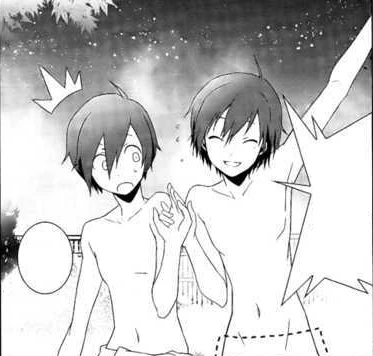
Sogabe, the P3 & P4 mangaka, chose to highlight how similar Ryoji and P3 Hero look. I consider it an essential element of their relationship together.
least favorite thing about them
It'd be cheating to say nothing, wouldn't it? I'd say that his design is easy to mock and hard to get right in fanart. Between Ryoji's forehead and very Axel Kingdom Hearts approach towards long limbs – and legs in specific – the movies did not help with this. I've read reviews saying how the higher budget allowed for the characters to be more consistently on model, and thus look better, but I fervently disagree. That boy is mostly leg. Late 00s and early 10s anime art Looked Like That, though. I'd be lying if I said I didn't have a soft spot for some of it.
But I love how Ryoji looks and wouldn't change it for the world. Silly slick-backed hair boy. It is funny how whenever Persona wants a villain with sympathetic qualities, they slick back the protagonist's hair (Philemon and Maruki come to mind).
Reload fixed ("fixed") this anyway but making him much fluffier in his portraits and giving his skin some color! He's achingly soft in that game.
favorite line
There's many iconic ones I could pick but I'm going to go with a new one from Reload:

It's so small, it's so playful! I like that if you choose to start an exchange he finishes the bit. It says a lot about him in such a succinct way.
Even more so when you consider the reason he came here was for Junpei's sake. Being able to balance joking around while keeping a touch of concern endears me beyond belief. Thank you, Reload.
brOTP
Junpei & Ryoji. It's not even close. This was the one element I was hoping Reload would show more and I was not disappointed! The dynamic is good for a variety of reasons, but chief among them is that despite Junpei's Persona being Magician Arcana, he is not the P3 Hero's Magician Social Link. Junpei is not the male protagonist's best friend. He clearly wants to be, but his frustration is palpable. The P3 Hero is cool, charming, and everything that Junpei plays second fiddle to, but he won't even acknowledge him. But what if there were a more likeable version of the Hero?
Instant friendship. Those two are besties from day one, where Ryoji has all the qualities but none of the knowledge, and so their dynamic is a much more even one. To me, it indicates how well Junpei and the P3 Hero might have gotten along had he not carried Death inside him for ten years. It's a brief window into another world.
There's also the fact that Ryoji, Death, befriends Junpei so close to when Takaya shoots him and he perishes. His character arc is defined by change, this act being what radically transforms his soul, and what's one of the meanings of the Death Tarot? It's like universal foreshadowing. It's funny to me too that the Magician Arcana Shadow is the one Thanatos tore to pieces. Growth for Ryoji too.
As an aside, I miss the dynamic movements from the PS2 cutscenes. Junpei being so quick to drown Ryoji is nowhere comparable to him covering Ryoji's mouth.

OTP
Hmm. This might take a second. I wonder what pairing I might like with Ryoji. Here's an unrelated picture of Messiah:
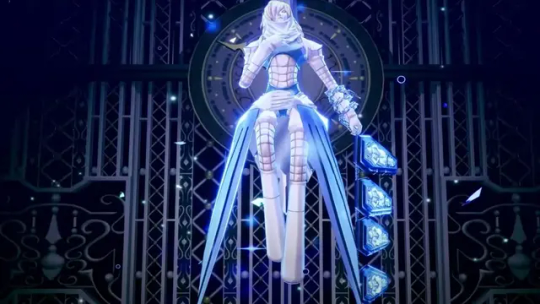
You know, Messiah is one of those Personas that has only grown on me more as time passes. My favorite of the final protagonist ones, due in part to how you have to fuse him yourself. Orpheus, the starting Persona, combined with the power of Thanatos, the penultimate manifestation of the Death Arcana. They compliment each other beautifully, and regardless of if you the player create him, he is always the true final Persona, the final result of the Judgement Arcana.

They are inevitable.
Of course it's Ryoji and P3 Hero. How could it be anything else? These two make me sick with joy. Death has a clear favorite and in the end, gets to keep him forever.
nOTP
It's funny, because I can't think of any serious pairing with Ryoji that I wouldn't view as a crack ship? I can't see any version of Ryoji with anyone but the P3 Hero nor can I take that relationship seriously. The only other being Ryoji has an established relationship with is Aigis, and that ship comes across as black comedy. I mean, there's also Ryoji and the P3 Heroine, who he is undoubtedly head over heels for, but I see her as heavily preferring Aigis. Oops.
Wait, I did remember one! Ryoji and Junpei! I'll admit, maybe it's the sheer "dudebro" vibe of their relationship, but people pairing these two was not an outcome I expected from Reload. I've seen it enough to know those who like it aren't joking, either.
It's funny, because they're both soul-taken at the tail end of their friendship (Ryoji with P3 Hero and Junpei with Chidori) so I guess I wasn't looking for it? Then again I can't see Junpei Iori kissing a man in general. If there's a Ryoji pairing that isn't my thing, these two are the Most not my thing.
random headcanon
Ryoji memory backfill!
I've seen multiple interpretations for how Ryoji's sudden transfer, housing, and parental situations were never questioned. I like exploring this for myself, especially from Ryoji's perspective. Ryoji fully believes himself to be human until 12/2's Dark Hour. So, how does he reconcile his own situation?
This headcanon states that whenever Ryoji is prompted to answer on where he lives, what he likes, or where he went to school before, he'll often "backfill" what memories he think should be there. If it's something he should reasonably know, it'll be there.
In-game you can see a couple instances of Ryoji being stumped at simple questions, like where his class trip was going to be, but excelling at others, such as when he asks Mitsuru out to a restaurant date. According to the headcanon, he failed the class trip question because it wasn't something he anticipated, but he knew a date location because it was essential to his personality. Ryoji Mochizuki is a hearthrob, it wouldn't make sense if he didn't. So he does.
I like to think Reload Ryoji's phone is another example of this backfill, though this one spills over into material items. Ryoji thinks he should have a phone and knows he should ask for others' numbers, but when he reaches for it on his first day it isn't there.
His inconsistencies are fun.
Rapid fire small ones: his favorite color is blue, he likes sunrises but not sunsets, and he's good with children.
unpopular opinion
This may be the most unpopular opinion I have in general, but I don't believe Ryoji is bisexual. Or rather, I don't necessarily believe he must be bisexual. It's not like I'm trying to shirk representation, but I think there are so many fascinating ways that you can analyze orientation for a character. Same with gender.
Ryoji, through my interpretation, is someone who could only love the protagonist. And it doesn't have to be a sexual kind of love. There's an entire spectrum of identities in our culture that we've labeled for what Ryoji's experiences could be. It brings me joy to be able to think about how – even if Ryoji knew about these identities – he'd define himself. On top of that, would how he define himself be accurate? Would he have misunderstandings about his own identity?
There tends to be a large backlash when someone even suggests a different label for a character with one widely agreed upon, which means my gender and sexuality thoughts stay hidden away. I'm more than aware of those that insist any hint of same-sex attraction is obviously platonic and fans are reading too much into things. I'd never want to take away from an individual identifying with a character for what a fandom settles on calling them.
Though one note: it's interesting to me that from the collective opinion I've seen, people have latched onto bisexual as a label rather than pansexual despite them ostensibly meaning the same thing. Something something changing social climate. Anyway. Play around with character gender and sexuality. It's good for you.
song i associate with them
Auld Lang Syne.
For old acquaintance be forgot
And ne'er brought to mind
Should old acquaintance be forgot
In the days of auld lang syne?
For auld lang syne, my dear
For auld lang syne
We'll drink a cup of kindness yet
For the sake of auld lang syne
-
It's a traditional New Year's celebration song. Auld Lang Syne essentially means "for old time's sake". It originates from a precursor to Scottish, and exists as a fossil word inside this otherwise Standard English prose. I find it sweet how this little, historic piece gets to survive through something that redefines it.
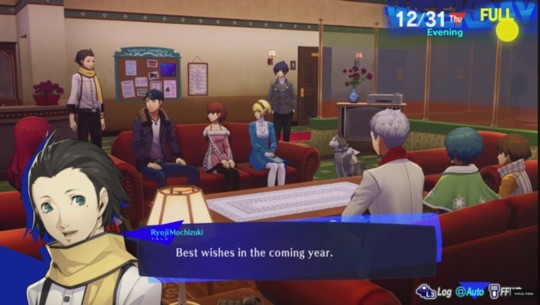
favorite picture of them
Well, that was a lot. If you have a keen eye, you might've already noticed I've been dropping in pictures so I'll keep this part concise.
My favorite pictures of Ryoji are his portraits:
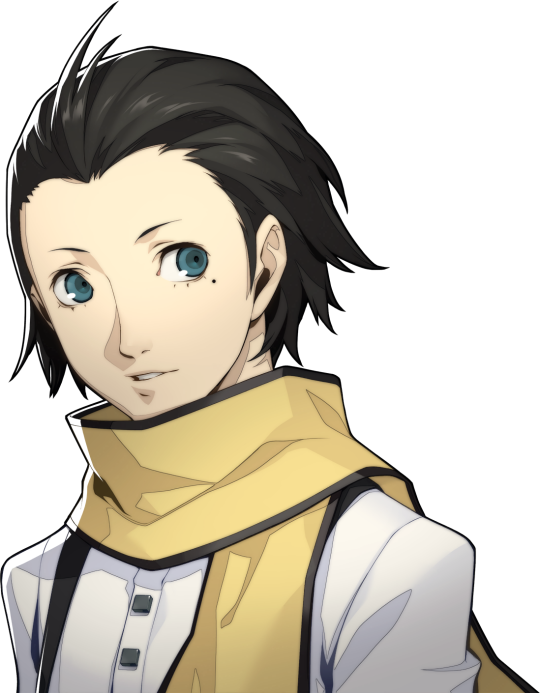
Sweet. Fluffy. Endlessly endeared by the way his hair flairs out. A much clearer heart shape for his face. Perfection. Special mention to his startled expression. His eyes get small and I get happy, simple as that.
Although, I'll never forgive Reload for dropping his Messiah pose:

There's an element to this portrait that's a little more unearthly, but earnest. Visually, his eyes are also a clearer parallel to Aigis's in this version.
Thank you for reading all the way through! And thank you again for the ask. I'm not sure if you were expecting an essay, but I think that about sums it up.
Have a picture of Ryoji nui + charm!
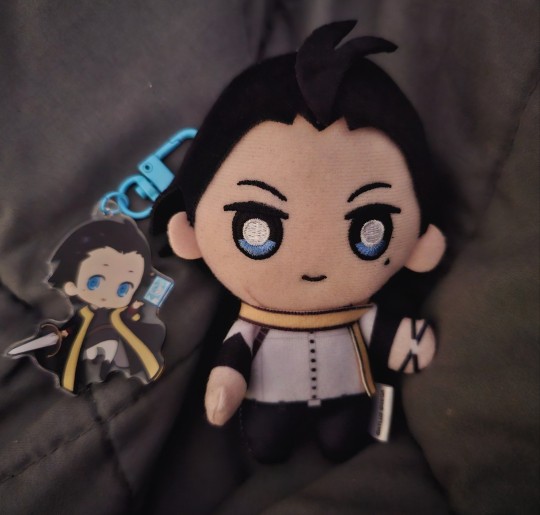
#asks#ryoji mochizuki#🔫#🌕#it took me eleven days to answer this that does not bode well for the others#elle-p's nomenclature is spreading#thanks Ver!#happy mochizuki monday#very-lucky
17 notes
·
View notes
Text

Spirit World #6 concluded the series this past week. Did it end on a high note? How was Cass within it? Well, all answers will be found here...
I love that this series fills the final gaps of questions I have for certain characters in the series. Namely, Wan Yujing's motivations, WHY the Jade Court are so meh due to Po Po's warnings back in #4. and how this ALL ties into the origins of Xanthe Zhou.
But like poetry, it also ties into Cass as into what she was going through in #1. Said issue, Cass was lost, but also feeling awful in helping slay a creature (even dark) and it took a slight toll on her.
Here in #6, it all circles back.
Seeing why Wan's desperation. Seeing the souls she's trapped. Seeing the Jade Court's inability to "want" to save the situation. All it ties into this isn't a simple solution of just slaying the demon.
But this doesn't just tie into Cass, but also the series' central character Xanthe. We get their full origin here. The mystery all pulled back and the scope of their powers revealed.
Writer Alyssa Wong sprinkled teases of Xanthe's origins throughout, and here they are on full display. You can also see why they keep company with John Constantine but also now open themselves to Cassandra Cain.

Why these characters just gell so nicely to each other complimenting it all. With how Xanthe finds the way to end this all.
For now at least.
The ramifications of this issue interestingly bring up new ideas for the DCU at large. Both in the mystical portion and well in Cass (more on that soon).
I find the whole mystical area of DC fascinating because they aren't just bound to one corner. Each magical user always brings something new to the table. Xanthe Zhou is just another character that I hope more tales are showcased with the character going forward.
The fact that well, not everything is tied up at the end leaves me to think that Wong has still so many more stories to tell of Xanthe and Spirit World itself. We've only touched the first layer of that.
To that, I hope allows the creative team to return and tell more tales.
The artist for the series, Haining has been exceptional with the various designs and actions throughout. Like I'm still in awe of the designs used or even how horrific Wan's demonic can be but Haining brings a level of cracks of her humanity through the body horror drawn.
That's not even bringing up the fluidity to the action we've seen throughout the series.
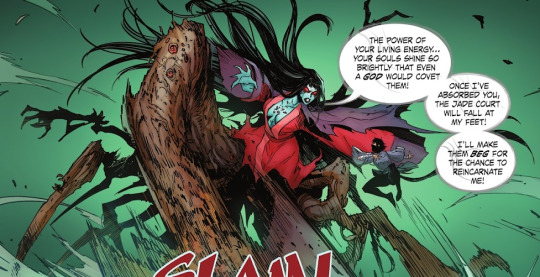
Every bit of the creative team brought their A-game to the table in telling something truly unique. Like I really want more.
And you get that there MIGHT be more.
Clearly, Wong lays seeds at the end of the Verdant Sorcess not at all pleased with the new status quo of Spirit World going forward.
I'm REALLY curious about their origins now with the reveal of the prior ones.
Not only that but in the case of Cass, only one of her subplots is resolved in the series. I mean yeah it's the big one: she gets to go back home.
But the "missing" time of her being in Spirit World (due to Batgirl Vol. 1 #72)? Why incident is all screwed (Shiva never killed Cass in that particular issue)? What new memories Cass lost in #3? Was Shen posing as Steph?
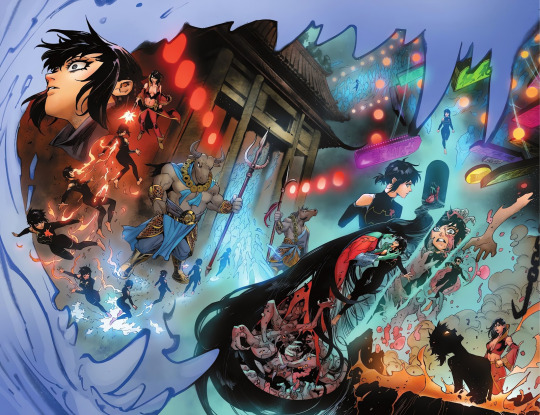
It feels like Wan found her, that while she was absorbing Cass, THAT's when Shiva brought her back. But it still doesn't answer fully what occurred with Cass during that lost time?
These are riddles still left unanswered, and it can't be coincidental given what next year being. So hopefully maybe THEN they are.
Please let Alyssa Wong cook DC!
Wong truly has an amazing grasp on the character and is the first to really bridge the lingering cracks Batgirl Vol. 1 left and bring it into this modern era.
Regardless, Spirit World was an exceptional series. It was something I truly needed to wash the sadness of Batgirls ending and another event douring the characterization of Cass.
I really hope DC goes all out in collecting this series. Show us all the Haining concept art.
Give me some words by Wong on how this series came to be. How they developed Xanthe Zhou. Give me it all!
.....
I've become Shen. My greed knows no bounds. 😅

Anyway, to those who haven't read this series. You now have the full excuse to read it all in one sitting. It's even BETTER when you do that actually. To those who read it like me keep hyping this and the other new minis DC created this year.
We need more of this!
49 notes
·
View notes
Text
This doesn't really have any deeper point, I just wanted to talk about what makes me like a main character by using the example of four of my favourite ones.
*Spoilers for Houseki no Kuni, JJK and Innocent Rouge*
Phosphophyllite & Itadori Yuuji
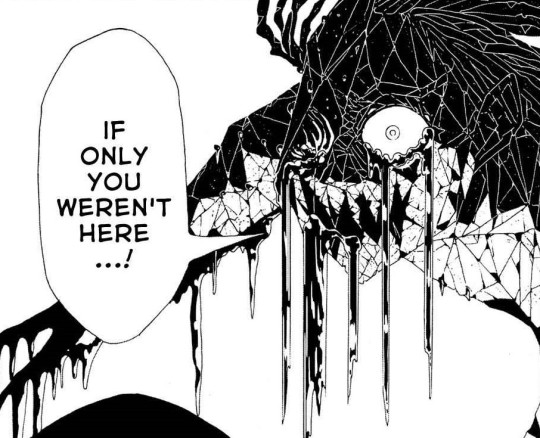
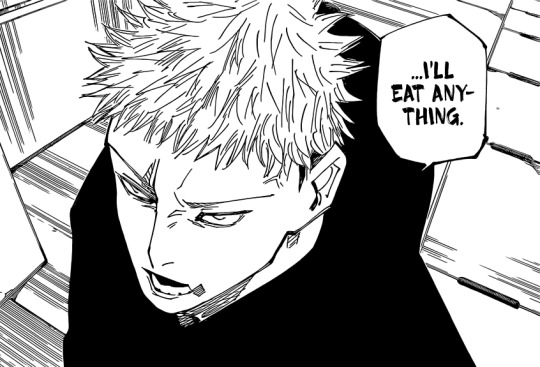
These two are undoubtedly my faves right now. As much as I like lists, it is hard to rank one above the other as characters because I love both so much and I think they are very well written. Phos might be slightly above because I think HnK is a better story and Phos better integrated into it, but they also have a slight leg up due to the series being almost over and their character development mostly concluded, while Yuuji still has what will likely be his most crucial moments (relating to his confrontation with Sukuna & Kenjaku) ahead of him. HnK is also clearly centred primarily around Phos, Kongo and their relationship, thereby they are given a lot more attention. JJK is more focused on its cast and while it all ultimately serves to develop Yuuji, the others are given ample time to be fleshed out as well. I might be a bit sceptical of recent developments in jjk, but I still think that its writing is at its best when it revolves around Yuuji. He is a very central character and it is clear how much Akutami cares about him and his journey throughout the story. Now onto why I like them and characters like them.
Phos and Yuuji both fall into the theme of loss of innocence, compromising of morals and gain/loss of humanity. Both go through traumatic changes that fundamentally and lastingly change them and that change is very physically noticeable. In Yuuji's case it is his scars and lost ear and pinky, in Phos it is essentially their entire body. Due to these changes the two have to grapple with how much of themselves and their initial convictions they can hold onto in a world that is out to hurt them. Everything they do is done out of a wish to protect the people they care about, but they have to realize that more often than not they are unable to help them and even bring more suffering onto others by merely existing or trying to follow their goals. Yuuji has a little less agency in that, since Sukuna running amok was not his fault and he could not have known the consequences of making a binding vow with him at the time it happened. Those kinds of innocent mistakes are what haunts both of them however. The story is ruthless in punishing them for every little misstep they make.
Both are also manipulated by far greater and more experienced forces that force them down a path of suffering to eventually become something greater. During that, both of them are objectified and given and taken away their humanity as the others please. In Yuuji's case it is Kenjaku, who literally designed him to be a vessel, cage and eventually pseudo-cursed object and with Phos it is Aechmea, the Doctor and to an extend Kongo. They are turned into a human through suffering only to be pushed into divinity and loneliness for the sake of the world at large. Phos has learned to come to terms with that. They had their revenge, endured 10.000 years of mental torture and managed to come out of all of that somewhat sane, if fundamentally different of who they used to be. It will be interesting to see how Yuuji will deal with the challenges that are waiting for him and who he will be by the end of jjk. It won't be as drastic as what Phos went through, but I don't expect that either. That's not the kind of story this is.
Also, both are characterized by their understanding of others. Yuuji can naturally get along with others, he has an intrinsic understanding of them and can see even minor specialities about them others would discard as unimportant. He also has his natural grasp on the soul that only increases as the story moves on. Similarly, Phos has the ability to understand other human-like lifeforms, even if they aren't gems. They can talk to the Admirabilis and hear the ice flows talking to them clearly. Phos is also the first one to try and succeed in communicating with the Lunarians, going so far as to imitate the air holes in their necks to establish a connection. Understanding others and emphasizing with them might not always be as easy for them as with Yuuji, but they do have a special way of communicating with and uniting others, even if that union is done by deception or against them. In both cases it comes down to the humanity within them that gives them this ability.
What ultimately draws me to these two and what makes me love them so much is the "corruption" arc they both go through. It is messy, they are never excused for what they do, the narrative doesn't coddle them and any personal flaw they have is pointed out and amplified in the story. All too often you have it that a main characters flaws are excused, they are given chance after chance and can handle challenges that others break at with relative ease due to whatever innate advantages. They are fundamentally good and the story doesn't dare to challenge that.
With these two it is different and I especially like how you can see the marks the story has left on them. They are also allowed to show darker sides. Phos' selfishness is brought up time and time again and we see how they hurt the others around them. Not only that, but in their quest to safe everyone, they end up going so far as to massacre their friends. Yuuji only tries to help, wants to find a meaningful death and despises sadism, but he ends up realizing that he has a similar cruelty inside him. He doesn't hesitate to kill if he has to and can be just as gruesome towards the people he hates, mainly Mahito and Sukuna. He wants to see them pay, suffer and die for what they did, he is not above that. That is honestly when I love him the most. He already had a chilling stare as a middle schooler and it has only gotten deadlier.
Marie-Josèphe Sanson & Charles-Henri Sanson


The way Charles changes from protagonist in Innocent to an antagonist in Innocent Rouge might be one of my favourite developments in fiction. He turns into what he tried to fight, all while having still somewhat good intentions and thinking he is doing the best for everyone, he's "just being realistic". He inflicts the torture his father put him through on his own children, thinking he is helping them harden and grow up. We are shown how this trauma and submission to the ruling class is a viscous cycle only someone as excentric and fearless as Marie can escape. She breaks the status quo by refusing to bow to any rules or accept any restrictions ever. Be they a country's laws or gender roles, she does not give a fuck.
Both have to struggle a lot in both parts of the story. Charles sees his grand visions for the future he had as a child compromised as he grows up, tries to keep his family from making the same mistakes and hurts them just as much in the process, which leads to him losing what he really cares about. He buried his attraction to men and his softer side and discouraged it in his children as well, only to see his son kill himself in front of him after he couldn't behead the boy he was in love with. He gets absolutely broken down for what he did and the path he decided to take.
Marie has to fight every step of her way. She has to be strong both physically and mentally or she would not have prevailed this long and reached her goals. Her own family despises her and tries to make her submit to tradition, gender roles, the class system, the queen, but she rejects all of it. She did not start the revolution alone, but she was an integral part of it and a strong hand that kept the people safe. I've seen people be upset with her end of the story, that after all she's been through she dies, but I don't really mind it that much. It was not a defeat and she has accomplished the most important thing by paving the way for a better future and raising a kid that can follow in her footsteps. She did not solve class struggle, but she was there to accompany the most important steps. There's only so much she alone can do, so it is all on the next generation now.
Tldr: What draws me to a main character is that they suffer, they have to be meaningfully and lastingly altered by the story and their flaws have to be explored and highlighted. Additionally, I also appreciate some moral greyness and if the topic comes up, they should be anti-establishment (I don't accept any bootlickers like Naruto). They don't have to change an oppressive system all on their own, but they should at least question it and work to better it. They don't have to succeed in their goals, but that loss shouldn't be brushed aside.
Some examples of other MCs I like and who fall into some or all of those categories:

Kamiya Toshiro (Fool Night) - Ai Coleman (Dorohedoro) - Johnny Joestar (jjba)
#this is basically just an excuse to talk about Phos & Yuuji#jujutsu kaisen#itadori yuuji#houseki no kuni#innocent rouge
35 notes
·
View notes
Text
Vex's big fat SV fic recommendation list
Being stressed while waiting for reviews and thesis feedback had me tearing through the SV AO3 tags like a rabid animal. Bright side to this is that I've been through basically the entire tag for a few characters so you don't have to. Below the cut is all the fics that really stuck with me
Invasive Species by hiratake
Hassel/Brassius oneshot. You know that popular post that says the holy grail of AO3 is a 10k oneshot that changes your life when you binge it at 3am? yeah that's this one they meant this fic. It's a look at their younger years and the falling in love stuff these two go through and it's fantastic. There's cute cameos, excellent prose and really fun themes throughout
Team Building (and other remedies for loneliness) by viodef
Arven Gen multichap. By the time I finished this fic I was convinced it's canon. It fills in the unseen parts of the game absolutely expertly, telling the story of how Arven caught and raised his team, and balances emotional angst and cute moments within his team flawlessly. It actually got me to care immensely about Arven's Toedschol. btw, this fic is part of a series-- and every fic in it is just as excellent as this one. They're some of the best Arven fics I've ever seen and I cannot recommend them highly enough
I Love You (just in case you didn't know) by WizardGlick
Hassel/Brassius oneshot collection. "Where are all the incredible writers for SV?" making old man yaoi content. The Hassel/Brassius scene on AO3 is killing it. This fic has been on my mind since I first read it, it's so GOOD. It's tender it's emotional it's cute it has it all. Even if you don't care for this ship you will by the end of it. Read it
normal people by golden_blue
Larry gen oneshot. I'm actually astounded at the charm people are putting into fics about Larry, a character designed to be as basic as possible. This is a fic that really just brings the pokemon world to life, giving so much depth to characters and making everything feel so grounded and lived in. If you like Larry, or even if you don't, read this fic, it'll leave you loving Medali and everyone in it
Kitchen Confidential by aclockworklemon
Zerotrio Gen Twoshot (for now). People who characterize the player's mom are the most powerful among us and this is as good as it gets. There's a lot of subtlety in how the characters emotions are explored through the perspective of the character's own mom, and honestly I just love a fic that feels so grounded and sweet. Everyone is characterized so well, and the conflicts feel so real and personal. Good times all around
lost in translation by fivveweeks
E4 gen oneshot. This fic is fucking hilarious I am actually begging you to read this one. One of the few times a fic actually got me to belly-laugh. Every work in this author's series about the E4 is equally as funny and equally as good so just do yourself a favor and read them all
holding onto the past (just like her) by centispores
Arven oneshot, focused on grief. This one absolutely destroyed me. It has a real mastery of prose, a slowly building sense of dread and confusion that really hammers in the emotional core, and a really good understanding of flow. Setting the fic to a flu delerium backdrop lets the author's talents really shine and also gut punch you right at the end! It hurts, highly recommend
Tenderhearted Trust by infaredlove
Jacq focused oneshot. SV introduced the best cast of side characters (the teachers) in the history of this franchise and some valiant authors took it upon themselves to just make banger after banger all about them. This is honestly a recommendation for this author's entire catalogue of work because I adore how they characterize the academy staff, Jacq especially. The prose is great, the feelings are tender, and who doesn't love seeing some nice stories about the adults in the room?
kids and their newfangled lingo by rentaldragon
Rika/Geeta oneshot. This one is less than 1k words and as cute as it is funny. It needs no introduction, it's got silly lesbians in it!!
Up the Creek by neutralize
Arven oneshot, focused on his failed attempts to heal Mabosstiff. Another ouchie of a fic. This one stings real bad, and the depth of emotion in this one is an absolute killer. The ever increasing desperation here and the ways that Arven's own trauma prevent him from reaching out or getting help for his own mental state are absolutely brutal and an incredible way of illustrating the pre-canon events. This one is rough but it's a very worthwhile read
YOUR _____ APPEARS ABNORMAL. by johnchurch
Larry oneshot, Geeta POV. This fic is absolutely genius and even if you don't like either character you have got to give it a shot. It's such a fun and clever way to integrate in-game glitches to an in-universe headcanon. Genuinely delightful. Also watching Geeta slowly lose her mind is more fun than I initially expected
Cool, Cool, Cool by Chumpy
Arven/Giacomo oneshot. Really and truly who is doing it like rarepair shippers. They are the backbone of fanfic society and I mean this. This fic is pretty lowstakes in comparison to the others on this list, but man is it cute. I love the characterization, the realism of teenage dialogue and all its awkwardness, and just the way the relationship progresses during the story. Sooo cute, give it a read!
Perennial by Seasonal
Penny twoshot. Fics that are canon to me. I'm not even sure how to properly articulate how much this just feels like a legitimate explanation of canon events that happened offscreen. This fic is perfect and also canon. Real to me.
The Fellowship of Glimmora by dragons_tree
Geeta multichap, unfinished. This is THE Geeta fic to me. The prose is incredible, the characterization is incredible, the worldbuilding is incredible. If you read one SV fic today make it this one, it will leave you with so many new thoughts on Geeta and her relationships with the gym leaders. Genuinely so so so good I think I would kill to get this fic to update again
Ortega's Drag Race by MimeOfATime
Team Star oneshot. This fic is canon in my brain. This is so real to me. The characterization is perfect, the worldbuilding is perfect, begging you to read this fic Right Now. Pls. For me.
Push by agendergrim
Professor-focused oneshot. This one is short and also just cracked my brain wide open. SUCH an interesting take on what happened to the other professor and well-written to boot. Do yourself a favor and read this one when you have a few minutes
Historical Perspective by n7punk
Sada/Raifort exes oneshot. No one understands Raifort like this author I stg. The characterization of everyone here is absolutely fantastic and is filled with concepts and ideas that feel so authentic to the story of the game. I too love disaster lesbians so this fic was an absolute delight
regret, reflected in crystal by Emolga
Turo and Arven focused oneshot. This one is INSANELY rough, big tw for child abuse and an absolutely gut-wrenching internal monologue about it. This fic is really heavy but insanely good, I had to sit down for a while to process it all when I was done. I highly recommend this to anyone who's looking for a fic to blow them away, the author is insanely talented and a master of their craft, but also OOF.
oh, just one more question… by pistachiosoda
Penny focused oneshot. Such a sweet Team Star character study, it's really neat to see the unique ways that each character speaks and reflects about the boss and how it serves not only to characterize Penny, but them in turn. This genuinely feels like it could be dialogue ripped from some DLC of the game. If you like Team Star def give this one a look
irony by mousewritings
Penny and Arven oneshot. This author REALLY understands teenage dialogue. It feels so real it's almost painful, so if you want something that's really gonna captivate you, give this a read. There's something about the way the characters fumble that feels really natural, and this author is extremely talented when it comes to dialogue and attitude. I adore this fic
Endearment by Sarajaye
Penny focused oneshot. Centers around Penny's feelings about her dad-- it's like 400 words and super sweet, just do yourself a favor and read it right now. Click on the link and go for it it'll take like two minutes. You'll thank me later.
Glimmer by WolvZephyr
Geeta focused oneshot. Good Geeta focused fics are few and far between, so it was fantastic to see one that really delved into her philosophy and attitudes and personality. This is one of those fics that really puts so much depth into a character that it feels like a natural extension of everything in game. Whether or not u think ur a Geeta fan, read this, because it'll absolutely give you a fresh perspective on her
Patch Up by ColourfulVoid
Nemona and Miriam focused oneshot. This might actually be one of, if not my absolutely, favorite fic I've read about Nemona. It so perfectly captures the masking she does and the ways that the adults in her life WANT to help but can't because of all the fronts she puts up. This is filed under lists of fics that changed my brain chemistry. Read it
hues by aukai
Nemona and Jacq focused oneshot. Similar to the above, this focuses on Nemona's unhealthy habits and masking and I just absolutely adore it. It's a brief glimpse into her pre-story school life and really adds depth to everything happening offscreen. Nemona my beloved
If you don't wanna use a tumblr post for the links, I have all these bookmarked on my AO3 Vex_ation, which is linked here
47 notes
·
View notes
Text
I really want to highlight the immense improvement that can be seen when comparing Mo Malto from Earthspark and Sari Sumdac from TFA.
Sari's name comes from a piece of clothing + "Cadmus" spelled backwards, she's voiced by a white VA (as is her father), and I was stunned when I realized she was seven at the start of the show because she is not written as a convincing portrayal of a child so young... this may be because she's a robot, but that's part of the issue. I don't think her racial identity was ever explored? While there were plenty of story possibilities surrounding, say, what it was like for her father to become such an influential inventor while being a person of color, I don't recall anything like that being discussed. Plus, later Sari gains permanent blue eyes and no longer resembles an eight-to-nine-year-old.
Whereas with Mo, it's very easy to accurately guess that she's nine based on her characterization even though she is very intelligent, and there are so many natural references to her heritage throughout the show! Her father being a history teacher especially helps with this, but the explorations are also as subtle as showing Mo's bonnet while she sleeps. I love the way her hair is animated, by the way! Her cyber-sleeve powers also don't get in the way of the rest of her design, either, and I appreciate that in the most recent episode she expresses very realistic fear upon using them.
As I'm sure people know, I like Sari a lot as a character, but I'm also so happy to see progress being made! The TF franchise has a lot to answer for when it comes to how it's portrayed race, and I think this is very promising and refreshing.
#my analysis#transformers earthspark#earthspark spoilers#transformers animated#TFA#Mo Malto#Sari Sumdac
81 notes
·
View notes
Text
Best Underrated Anime Group F Round 1: #F8 vs #F1
#F8: Young boy gets sold to a demon to be his grandson
Iruma Suzuki is sold to a Demon by his abusive parents. Fearing for his life, he is greatly surprised to learn that the demon bought him because he desperately wants a grandson. Iruma agrees, as he is unable to say no when anyone asks him nicely for something. He thus begins a new life in Babylus. However, he needs to hide the fact he is human, or he may be eaten by other demons. Throughout the series, we see him grow as a person and embrace this new life, making many friends along the way, including his closest friends, Asmodeus and Clara.

#F1: High school girls go to Antarctica
16-year-old Tamaki “Kimari” Mari wants to make the most of her adolescence when she encounters Kobuchizawa Shirase, a schoolmate who has saved up one million yen in an effort to travel to Antarctica after her mother went missing on an expedition there three years ago. The two team up with Miyake Hinata, a convenience store employee their age who’s looking for an adventure, and Shiraishi Yuzuki, a teen star who’s never had friends due to her career. Together, they travel to “a place further than the universe” as part of a civilian expedition to Antarctica.
Titles, propagandas, trailers, and poll under the cut!

#F8: Welcome to Demon School! Iruma-kun (Marimashita! Iruma-kun)
youtube
Propaganda 1:
The main character, Iruma, is very kind and wholesome, and you really just want to see him succeed throughout the series, especially after knowing everything he’s been through. He was neglected and used by his parents, but now he gets to live out a nice life despite being surrounded by demons, as his new grandfather spoils him. The demon that adopted him, Sullivan, is an extremely powerful figure in the demon realm, but through most of the series, he looks like an egg. The side characters are also well-designed with interesting personalities. The main two, Asmodeus and Clara, become almost inseparable from Iruma after they become friends, and the three of them are very cute together. There is also a canon nonbinary cat person, who is technically Sullivan’s servant, but he is treated as part of the family, and he’s a disaster bisexual.
Propaganda 2:
It’s really good in terms of art, plot, and characters. There’s nonbinary representation in the form of Opera, and there’s friendship galore with very poly undertones. It’s so sweet and good, and it’s just rahhhhh. Everyone is silly but also realistic and well-developed. There are reasonable arcs, and there’s a well mix of plot-driven growth and character-driven plots. I love every person who appears onscreen, even for like two seconds. The world building is lovely and so bright and colorful.
Propaganda 3:
You should vote for it because it is genuinely one of the best animes I’ve ever seen. It has good character development, mysteries, focuses on the cast well, and it is not a harem anime. The plot is also really good and is suitable for all age groups.
Fun fact: the main character crossdresses three times in the first three seasons
Trigger Warnings: Child Abuse (mild)

#F1: A Place Further than the Universe (Sora yori mo Tooi Basho)
youtube
Propaganda:
Let’s start with the fact that this is Madhouse doing a (relatively) grounded coming of age story about high school girls - the show looks gorgeous, of course. The music’s solid as well. (I still regularly listen to the ending.) But what really shines is the writing and characterization.
The pacing on this is perfect. For a show that spends half its runtime getting to Antarctica, you never feel like the time should be allotted differently or that you’re missing out on hijinks. Episode 12 is a particular standout, with tension building up until it explodes, and then goes still for the true emotional climax of the show. The four main girls all feel like believable teens, and seeing their relationship develop over the course of the series and watching them come into their own is well-done. The way it handles Shirase and her emotions, and how this complicates her relationships with them all is a particular standout. This may not be eligible in that it’s one of those anime people who watch A LOT of anime will recommend highly—it was on Crunchyroll and IGN’s best anime of the 2010s lists and on several “best of” lists for 2018. But it never quite took off the way it truly deserves, so I’m submitting it. It’s getting an English dub soon, though, and I really hope that gives it a resurgence of popularity. The girls are alright.
(Admin: Propaganda has been edited slightly to remove spoilers)
Trigger Warnings: None

If you’re reblogging and adding your own propaganda, please tag me @best-underrated-anime so that I’ll be sure to see it.
#anime#best underrated anime#polls#poll tournament#tournament#anime tournament#animation#animated show#group stage#group stage round 1#tournament polls#welcome to demon school iruma kun#marimashita iruma kun#a place further than the universe#sora yori mo tooi basho#marimashita! iruma kun#group f
16 notes
·
View notes
Text
Jen Tortures Herself With Every Dreamworks Animated Movie Ever: How to Train Your Dragon: The Hidden World

Alright it's time to out myself in front of the entire HTTYD tumblr fandom. I like this movie. A lot. Ok? Like I think its really fucking great and I will not deny that. Is it as good as the first two entries in this franchise? No, but it's still damn solid in its own right. So let's get into it.

We pick up a year after the last movie, with the arrival of another new threat to Berk, the "Night Fury killer" Grimmel the Grisley. To protect his people and their dragons, Hiccup moves the entire tribe to a new island while in search for the Hidden World, an unreachable utopia for all dragonkind. Meanwhile, Toothless is allured by the arrival of a new, mysterious female dragon, the Light Fury, which complicates matters even further as Hiccup begins to worry that he and Toothless are growing apart.
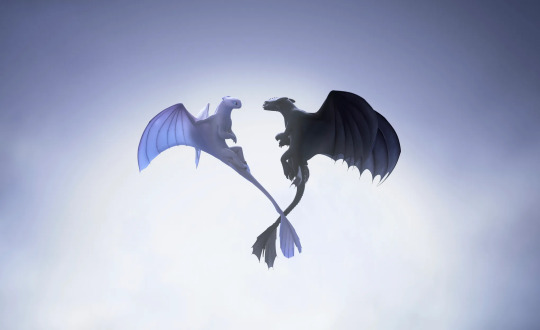
So yeah still a pretty good plot, though not as solidly cohesive as the first two. Still, I enjoy the ride here a lot; we still get a lot of great scenes of the riders fighting their foes, lots of great flying scenes (especially that one between Toothless and the Light Fury, man that scene is just gorgeous), lots of action and strangely enough, a bit more of a focus on humor here than usual? I mean it's ok, but a little strange given this is the final entry in the franchise and the stakes are supposed to be higher than ever.

Speaking of stakes, let's talk about that. Grimmel is by in large the only real new character here (aside from the Light Fury I guess, and she's fine, I don't understand the hate towards her design, I think she's cute). And he is... probably the lamest fuckin villain in this franchise, there I said it. He's just... some dude. He's nowhere near as unhinged and intimidating as Drago, nowhere near as smart or interesting or even just fun to watch as any of the villains in the HTTYD shows, he's just... idk man, a really boring villain. Certainly not what I think the "ultimate" challenge for a protagonist as well developed and interesting as Hiccup should be imo.

I know there are plenty of complains thrown around about this movie, the other riders are poorly-characterized, Grimmel is a lame villain (as I just said, I agree with that one), and of course, it's biggest controversy, it's ending. But here's my take on the ending. I think it's actually pretty bold of them to have the dragons leave? Like yes, there is a heavy sense of finality to it, but that's sort of the point. There's a massive change to the status quo, it feels like a genuine ending with little in the way of Dreamworks doing what they always fucking do in trying to bait any unecessary sequels. And then of course, there's the epilogue, which may be one of my favorite scenes in the entire franchise. I literally cannot watch it without crying, I'm such a fucking wreck for this boy and his dragon oh my god.
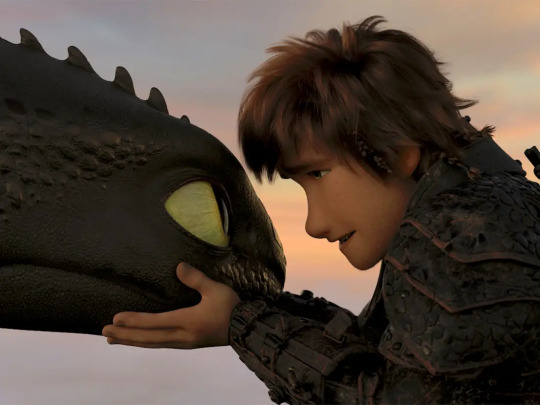
As usual, visually and audibly, this movie is absolutely wonderful. The animation here is especially impressive, the lighting took my breath away in some spots with just how realistic some of it looked, while still maintaining the series' usual style. The Hidden World especially, we don't see it for very long, but it is so damn pretty to look at. The music is, of course, also absolutely lovely, once again drawing on familiar themes from throughout the series to send it off one last time.

There's lots of other little things I love about this movie too, like the flashbacks to Stoick and Hiccup when Hiccup was little (I cry), any cute Hicstrid moments, especially the wedding (I cry), Toothless being an absolute mess while trying to impress the Light Fury (I die laughing), just... god, it's more How to Train Your Dragon, man, I fucking love this franchise, how the hell can I possibly hate this movie when there's still so much of what I love about the first two in here?
I do understand, this movie is flawed in some pretty big ways. And yet... it's still so beautiful all the same. I adore it, even if others don't, and I think that's ok? We can all enjoy different things and I just so happen to enjoy this. No, it's certainly not the best this series can do, and maybe the HTTYD franchise does deserve a better conclusion. But for what we got, well... I think it's pretty damn great all the same.
Overall Rating: 9/10
Verdict: How to get your dragon some rizz bc gottdamn he needs some

Previous Review (Captain Underpants: The Epic First Movie)
Next Movie (Abominable)
#jen watches#how to train your dragon#how to train your dragon the hidden world#dreamworks watch#dreamworks#jen tortures herself with every dreamworks aniamted movie ever
13 notes
·
View notes
Text
Candlestick of God
by Adam Kenichi Wekarski

As one who has been completely fascinated by the actual reality of Nuclear Warfare (since my childhood), I have always found the creation of the Atomic Bomb to be the most important moment in all of human history (with exception of the actual beginning & origin of humanity & all of existence itself).
Christopher Nolan’s perfect film, “Oppenheimer”, is a significantly honorable & highly-sophisticated masterpiece that provides a cinematic insight into the individuals who were instrumental in the real life happenings of the theoretical design, creation, and eventual utilization of atomic power (as a means to an end) in one of the most defining moments in all of history.
Julius Robert Oppenheimer (portrayed Perfectly by Cillian Murphy in his finest performance) is the main focus of Nolan’s awe-inspiring cinematic achievement. Often considered to be “The Father of The Atomic Bomb”, J. Robert Oppenheimer (known commonly among his peers, family, and friends simply as, “Robert” and/or “Oppie”) was born in a Jewish household in New York City, New York, U.S.A. on April 22nd, 1904.
Born of a painter (Ella Oppenheimer/Mother) & textile importer (Julius Seligmann Oppenheimer/Father, respectively), J. Robert Oppenheimer is portrayed in the beginning of Nolan’s work as one who has an inherent appreciation for the beauty of artwork (in a somewhat subtle manner), showcased in a rather pensive moment in the beginning of the film (a moment slightly reminiscent of the end of the museum sequence in the American classic, “Ferris Bueller’s Day Off”; perhaps a deliberate cinematic nod). While the initial years of Oppenheimer’s life are not the main focus of this picture (Written & Directed Perfectly by Christopher Nolan), the film itself is based off a biographical book entitled, “American Prometheus: The Triumph and Tragedy of J. Robert Oppenheimer” (a monumental literary undertaking in it’s own right; championed by Martin J. Sherwin & Kai Bird, respectively).
Although the book is based on Oppenheimer’s life’s work (among other things), the film is a three-hour-epic which tells a tale of various meanings:
Firstly, the life of J. Robert Oppenheimer, which picks up in this film at the time of his initial years of his scientific legacy, as a student at The University of Cambridge (in Cambridge, England). In his academic years, Oppenheimer was not regarded with favor on the behalf of his scientific community. He had humbling beginnings in the scientific field, regardless of his inherent genius (which he would continue to enthrall himself in his own time). A particularly disturbing, yet accurate, moment in the film occurs when Oppenheimer actually attempts to poison his own instructor due to his considerable dissatisfaction of his experiences at Cambridge (without spoiling the story, this obviously does not come to fruition).
What does come to fruition, however, is the continual movement of subatomic & atomic particles working within the inner-structure of the mind (and overall being) of one J. Robert Oppenheimer (while he continues his pursuit of higher learning & his genuine love for all things astrophysical & theoretical science). Christopher Nolan’s film has a perfect ability of providing a visual interpretation of various scientific theories (whether it be conceptual or experimental) all-the-while providing a visual display of the deeply conflicted characterization of Oppenheimer himself throughout the entirety of his journey (via Murphy’s award-worthy performance). The cinematography of the film Oppenheimer is absolutely perfect (showcasing the undeniable superiority of film versus digital photography). The beauty of the picture is matched by moments of visceral intimacy (going in and out of focus at times with confidence) as well as larger-than-life & monumentally jaw-dropping imagery (especially during “The Trinity Test”). The musical score composed by Ludwig Göransson is a true work of genius as it creates an experimental (and highly profound & meaningful) atmosphere that helps shape the cinematic world within the film “Oppenheimer.” Göransson’s score is a refreshingly beautiful balance of symphonic & orchestral instrumentation while incorporating a tasteful implementation of electronic & synthetic instrumentation to balance the overall structure of the film. As Oppenheimer’s innermost thoughts & flashes of brilliance are scattered across the picture throughout the entirety of the story (with visual flair & editing mystique in a nonlinear method, indicative of Nolan’s directorial style), the musical score accommodates the plot & picture perfectly with a sincerely divine grace & power.
While speaking on power, the notion of atomic & nuclear power is the driving undercurrent of the film’s main protagonist as the story unfolds. As the theoretical possibilities are literally astronomical within the understanding of Oppenheimer’s significantly educated mind (as he displays a fascination for existence at cosmological proportions) - the threat of nuclear weapons being constructed and crafted by the dark forces of Fascism (by Hitler & The Nazis) halfway across the world is the other driving undercurrent of the film’s plot and main characters (all of whom, in real life, did actually place their lives on the line for the sake of our world). The known reality that the Nazis of Germany & Austria (of old) had already devised their own plan to have the ultimate weapon to command their own will over the will of others (as their invasion of Poland was merely a first step in their agenda) was not far from Oppenheimer’s mind as well as the many key individuals of whom had not only shared time with him in his life, but had become spiritual warriors of the cause to stop (once and for all) the unGodly atrocities birthed from the minds of actual evil in Nazi-era Germany.
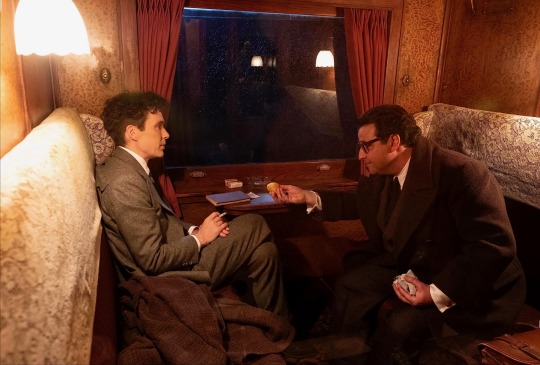
Key individuals had indeed entered Oppenheimer’s life; individuals like Isidor Rabi (portrayed gracefully by David Krumholtz in his finest performance on screen to date), Ernest Lawrence (portrayed very impressively by Josh Hartnett in his finest performance yet), Lewis Strauss (portrayed masterfully by one Robert Downey, Jr. in his greatest performance since “Chaplin”), Jean Tatlock (portrayed strongly by Florence Pugh in a highly provocative & deeply off-putting performance), Leslie Groves (portrayed incredibly by Matt Damon in my favorite on-screen performance by him since “Good Will Hunting”), Katherine “Kitty” Harris (who would later become Katherine “Kitty” Oppenheimer in real life and in the film; portrayed Perfectly by Emily Blunt in one of my favorite performances in the entire film), as well as many, many other key individuals who played significant roles in the organization of the atomic bomb in order to end what had become known worldwide as “The Axis of Evil” in [accurate] historical documentation.
The countless individuals who shall remain in the history books as having been directly associated with the formation of the U.S. Military effort (not to mention Canada and The United Kingdom, respectively) to create the Atomic Bomb are represented with dignified refinement in Christopher Nolan’s masterwork, “Oppenheimer.” The ensemble cast is enormous, and no one single performance can be understated by any other performance. Every performer on camera honorably captures an accurate portrayal of the manner of which these real life individuals had lived (granted with a dramatic tone mostly reminiscent in any major motion picture’s cinematic retelling of any major historical world event to connect an overall thought to anyone of whom views the picture).
In addition to the enormous ensemble cast is the enormous production design of the film. It’s particularly astounding to observe how Oppenheimer had become involved in the most important government protocol known to modern society, and then had the most important responsibility of practically producing a space within the nation to run highly-classified government operatives & lead numerous scientists (of both men and women) to create something that had never been physically manifested before by anyone. Cillian Murphy’s charming on-screen dynamics with his peers & colleagues (even among some of the most fascinating & completely serious situations; i.e. The personal politics becoming an element of interference & conflict even among the very people who worked as a team to construct the nuclear solution to the atomic problem; the complete classification of his work due to the priority of the U.S. Military; the priority of national security; his overall personal relationships while putting a new team of scientists together to perform the most massive scientific undertaking in a race against evil) - is just as organic as it is compelling to observe on film.

The reality of Oppenheimer’s associations with the Communist Party (as well as his own family members and friends) are presented very clearly throughout the entire film. Regardless of the numerous verbal warnings from fellow scientists such as Ernest Lawrence to keep politics outside of the laboratory (due to Oppenheimer’s rather open and highly vocal political opinions in favor for the Communist ideals with an intensely pro-worker stance), Oppenheimer continued to struggle to find the balance between his own personal convictions & morals as an individual as well as working within the functioning realm of national loyalty & honorable servitude. As the film continues into the development of Oppenheimer’s leadership as an instructor for his own students (which continues to increase in numbers), he eventually calls upon the brightest and most capable minds within his field to join the cause of stopping the world from being totally annihilated by the forces of darkness (as the Nazi army had continued to murder & genocide countless innocent lives in Europe on a daily basis and intended on dominating the world by total violence & mass genocide).
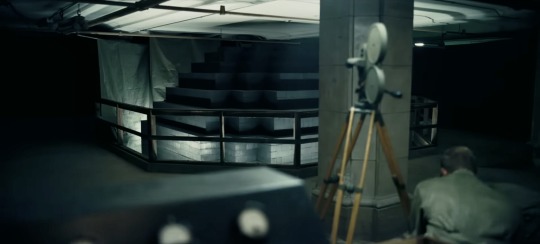
With a newly formed team and his continued work alongside Leslie Groves (a true man of the cause; a decorated Engineer of the U.S. Military who did his service to his country with much Pride & Honor) to build a physical location to perform what would later be referred to as “The Manhattan Project” (which was a perfect recreation in terms of production design of the classified military operation in Los Alamos, New Mexico, U.S.A.), Oppenheimer’s vision had come to fruition in the most tangible form (with the relentlessness of Groves throughout the entirety of the nuclear arms race). After the painstaking search for the perfect team to create the most destructive force known to humankind was completed (even with a briefly elusive encounter between Oppenheimer & Albert Einstein [portrayed by Tom Conti with awe-inspiring perfection & grace] in the beginning of the film when Strauss extends an invitation to Oppenheimer), the increase of scientific gravitas becomes ever more present with each scene in the film and each additional scientist of whom helps construct “the weapon to end all wars.” With each additional individual who presents more & more ideas to the table (so-to-speak) on how to successfully achieve the most effective scientific results (during an intimate look inside the American think-tank that constructed the weaponization of atomic power), the collaborative efforts put forth by the men and women who built the atomic bomb was frequently rife with conflict & tremendous disagreement due to the meeting of massive minds (often harboring massive ideas & massive egos to boot).
The potential security threat that Oppenheimer’s Communist ties initially raised had been dissolved by Leslie Groves due to his concrete belief in Oppenheimer’s intellectual abilities as a Scientist. This clear confidence, regardless of personal reservations, is what prompts Robert Oppenheimer’s brother, Frank Oppenheimer (portrayed respectably by Dylan Arnold) to join the highly classified government operation to defeat the Nazis in the race for atomic power (regardless of his clear ties with the Communist Party). The cause had become greater than us all as our personal politics and personal reservations regarding who did [or did not] pose a potential security threat to our nation had been placed as a postponed priority during a race against time (and an actual race against evil). Just as it has always been (in regards to the most important moments in human history), desperate times called for desperate measures. This is the compelling beauty of the unified cooperation & sincere teamwork that had actually happened in real life with real human beings who truly did save the world from the further influence of the destructive forces of darkness (and our absolute end as an overall existence). Regardless of differing political ideologies, many individuals came together for the common cause to stop the world from succumbing to the most sinister darkness ever known to be (by collectively constructing a proverbial candlestick of God to bring forth from the heavens the ultimate force of light).
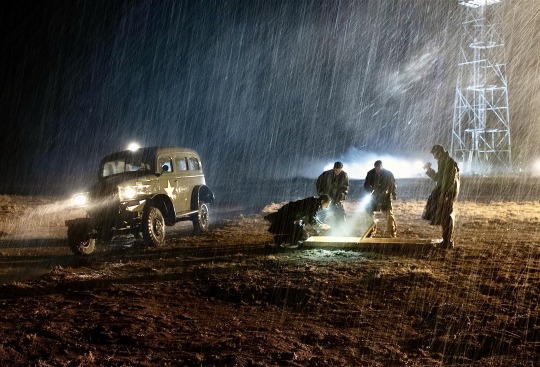
Secondly, “Oppenheimer” is a picture about the tragic betrayal & political persecution of J. Robert Oppenheimer despite his awe-inspiring commitment & loyalty to The United States of America as a government and as a nation (as well as the entirety of humanity and existence on Earth). The second act of this three-act work of art is primarily focused around the McCarthy-era “Red Scare” that occurred in America that followed the aftermath of the end of World War II in the following decade. The Red Scare had essentially been a witch-hunt in contemporary America for anyone who was a Communist, held affiliations with the Communist Party, or was suspected of having potential connections and/or ties with any individual(s) or organization(s) associated or in some way, shape, or form, and/or of having any relations with Communism as a whole (very reminiscent of another important socio-political picture focused on the era of McCarthyism in America entitled, “Good Night and Good Luck”).
Regardless of Oppenheimer’s complete commitment & sincere dedication to the cause of our great nation, he was still held under a severe amount of scrutiny and political punishment for his past associations with the Communist Party. In addition to a public hearing which had placed his entire scientific credibility & honor as a man under an unnecessary humiliation that attempted to destroy his life, family, and career - He also faced a significant amount of antagonistic questioning on a daily basis regarding a tapestry of arbitrary & meaningless questions that were implemented more severely & viciously with each passing day in order to further diminish, attack, and otherwise destroy his character (regardless of him & his family’s sacrifice for the greater good).
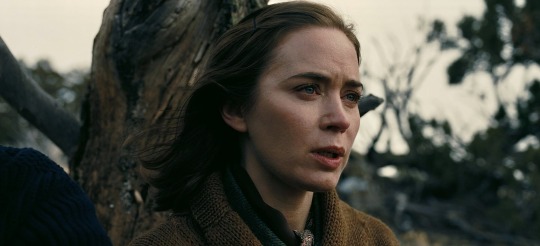
The second act is duplicitous in the sense that it’s nonlinear in it’s presentation (similar to the earlier work by Nolan, “Memento”). Act two is primarily in black & white, a clear indication of the nature of the duality of Oppenheimer’s scientific & humanitarian achievement in that he was once an exciting figure full of potential in the first act (with a sense of hope & color & adventure), and now the second act has him facing questions (in a stark contrast to act one) regarding his own character and his associations (in addition to the very achievement he was called upon in order to save the world from total annihilation, by the very people who asked for his help). The second act happens simultaneously with the first act which is a stroke of genius in the direction, writing, and overall production quality of the film. Without revealing too much in order to preserve the quality of the picture, the second act is a complete torment on Oppenheimer’s character and his actions and overall judgment calls (as the man responsible for having a scientific team working for the U.S. Military & U.S. Government that actually had Russian spies and double-agents infiltrating classified U.S. intelligence during The Manhattan Project and The Trinity Test). The truly unfortunate reality is that Oppenheimer, while being a genius who worked alongside many, many brilliant & wise individuals, still managed to succumb to the double-cross of individuals of whom were trusted with the highest security clearances in our own U.S. Government (while covertly operating within the means of international political subversion & government espionage).
While I will not indulge further into the premise regarding the socio-political plot-related themes of the film, I will indeed acknowledge the Kubrickian fashion in which Nolan has immersed his direction in this particular film (in all of it’s 70mm glory). Without spoiling the story for anyone; there is one scene during Oppenheimer’s questioning where the film provides a visual representation of how deeply each question had cut Oppenheimer as a person (and character). What would seem to be a completely gratuitous sex scene during Oppenheimer’s questioning (courtesy of Florence Pugh & Cillian Murphy, both in a highly artistic light), is actually an astonishing symbolic gesture that showcases the real suffering that was not only endured by Julius Oppenheimer (having been known for his illicit affairs), but also his wife, Katherine, during one of the worst times in Oppenheimer and his family’s life (which fed into Kitty’s alcoholism despite her own intellect & genius in real life). The questions of Oppenheimer’s commitment to our country, and to the greatest cause in the world, and the questioning of his personal affairs in order to smear his good name was discovered to be a deliberate method of private interest (facilitated by an individual later revealed in the film).

Oppenheimer’s credibility & worthiness had been completely tested, challenged, and disgraced regardless of the fact that he utilized his intellect (and the intellect of countless individuals in his immediate life that had all worked together) in order to bring an end to the forces of darkness by using the most powerful form of light: Atomic Power.
Thirdly, Christopher Nolan’s monumental cinematic achievement is, symbolically-speaking, about the Greek tragedy of the Titan known as Prometheus (originally based off of Hesiod’s ancient mythological poetry, “Theogony”; as well as the 5th Century [B.C.] epic trilogy written by Aeschylus, “Prometheia”; a trilogy of tragedy consisting of “Prōmetheús Desmótēs” (a.k.a. “Prometheus Bound”), “Promētheus Lyomenos” (a.k.a. “Prometheus Unbound”), and “Promētheús Pyrphóros” (a.k.a. “Prometheus The Bringer of Fire”). In the calculated words of Oppenheimer, himself, as he identifies with the paradigm of which confined Prometheus before him, “…I am become Death, the destroyer of worlds…” (taken from Eastern Philosophical Sanskrit spiritual text; quoting Vishnu of the Hindu faith; Bhagavad Gita, approximately 4th Century BCE). As Oppenheimer’s ability to “bring fire” to humanity (a cinematic similarity of the mythological tragedy of Prometheus), having stolen fire from Zeus and having given it to Humanity (in addition to civilization & science & knowledge from the heavens), the mythological being’s tale had become an obvious parallel to Oppenheimer in his actual waking life (when he was indeed alive on this earth and did aim to wield the power of the universal light). Regardless of Oppenheimer’s world-changing achievement (and the further harm it would prevent on a mass level), he was still able to intellectually determine his own profound understanding of the bloodshed & death that would be the result of his scientific creation (despite the necessity to stop the seemingly unstoppable armies of Germany & Japan at the time). Oppenheimer, like Prometheus before him, had successfully managed to reach for the stars and pull the light down from the heavens, and bring it to humanity on earth in order to prevent Zeus from completely obliterating and destroying humanity as a whole.

In Nolan’s masterpiece, as Prometheus had learned the ability to seize the power of fire could indeed be harnessed from the heavens, Oppenheimer had learned the ability to seize the atomic power that could actually be harnessed from existence itself (as the molecular structure of all existence as we know it is indeed a physical result of atomic activity combined with spiritual energy [individually & collectively]) within an interaction between the tangible & intangible forces of cosmic energy & matter & waves of sound.
As in the tale of Prometheus, after having brought fire to earth from the heavens, the following punishment was the eternal torture & torment of Prometheus (condemned by Zeus). Prometheus was shackled to a boulder, as his immortal liver was eaten on a daily basis (having the ability to regenerate each day) by an Eagle (typically identified as the emblem of Zeus). In a contemporary context, an eagle also identifies as a symbol of State Power; Authority of The State; Government Power. Zeus, in Nolan’s cinematic interpretation, has a much more fascinating and complex representation via two different major political figures (both Adolf Hitler as well as President Truman; the inherent duality of state power). Without giving anything away - The brief cameo of President Truman (as he and Oppenheimer meet) is an encounter similar to that of when Peter Finch’s ‘Howard Beale’ meets Ned Beatty’s ‘Arthur Jensen’ in the film “Network” (albeit more brief). While Oppenheimer’s brilliance and complete concern over the social responsibility of striving for a world where we no longer need to use any such weapons in order to remain a functioning society - President Truman (portrayed masterfully by an actor who shall remain nameless to maintain the integrity of the picture) shows the true nature of the political world by declaring the contrary and asserting a further implementation of research & development to deter any further international threats (regardless of Oppenheimer’s clear concern of any government having such access to such extensive means of weaponized methods of power on the nuclear level).
It’s a truly fascinating & monumental statement to have applied the cinematic telling of one of the most important moments in human history while simultaneously bringing forth poetic symbolism of a Greek tragedy (utilizing the most powerful form of cinematic triplicity; particularly with the utilization of Einstein who plays more like a force of nature rather than a man). The third act of the film releases Oppenheimer from his proverbial rock of eternal torment in his own modern Tartarus, as he is released by the help of the every-day scientist, David Hill (portrayed perfectly in a minor, but completely effective role by Rami Malek). As Heracles before him, Hill’s presence sheds new light on an intriguing internal development within the scientific community which not only shows the duplicitous nature of the second act, but also the duplicitous nature of the individuals of whom had called upon Oppenheimer to help create the atomic bombs that would be dropped on the civilian cities of Hiroshima & Nagasaki, Japan (respectively). Rami Malek’s brief, but significantly important role in the film is the pivotal turning point that grants Oppenheimer, his family, and his associations (both past and current) freedom from previous prejudice & extreme ridicule (in a gratifying on-screen showdown that brings forth the most important message of the entire film).

Lastly, and most importantly, the overall message of Nolan’s masterpiece is about honoring the people who deliberately rise to the occasion in order to save the good grace of humanity & the sanctity of life as we know it (regardless of prior or potential political affiliation or one’s professional ego or private interest). The importance of speaking up on the behalf of the ones who do good in the world, and celebrating each achievement in order to propel the individual (and the collective) further into the future is essential in all industries (not just the scientific field). The ones who literally step forward to save & preserve the fate of humankind & our world (by intellect, spirit, or body) should be awarded for their good faith (not punished or tortured or removed by exclusion due to the absurdity of bureaucracy or envious competitors or kicked back into the world merely as paupers, or as the film refers, a “Lowly shoe salesmen”).
In conclusion: The elusive moment between Einstein & Oppenheimer (which comes back around full circle from Act one through Act three) is a highly powerful moment on film that provides an insight into the purity of true genius & brilliance (more importantly & above all else: a wisdom that burns inside within the spirit of Oppenheimer as it had in Einstein; a candlestick of God’s light from within: All-Knowing, regardless of the tumultuous path ahead of the man that became known as “The Father of The Atomic Bomb”). The beauty of the film is not one individual’s achievement, but the collaborative achievement of the goodness of humanity as a species in order to stop the darkest evil known to humankind. It was one individual who lead a team of individuals (with unmeasurable personal & professional sacrifice on everyone’s behalf), a true human being alongside other noble human beings who did what was necessary to preserve the sanctity of life as we cherish it to be. Considering the known reality that the relevance of an actual threat of nuclear warfare still exists in our modern time (approximately one century after the real atomic bomb had been created by the most important team of individuals who placed, not only country above party, but humanity above it all), perhaps Christopher Nolan’s cinematic echo of the past will allow us all to consider the priority of humanity’s future as we look towards a better time, not just for a certain few, but for ALL of us as an entire world (now & forever).

#Oppenheimer#CillianMurphy#EmilyBlunt#MattDamon#RobertDowneyJr.#FlorencePugh#DavidKrumholtz#JoshHartnett#MatthewModine#TomConti#LudwigGöransson#HoyteVanHotema#ChristopherNolan#EmmaThomas#JuliusRobertOppenheimer#HeinrichFriedrichFüger#Movies#Film#Art#CandlestickOfGod#AdamWekarski#AWESOME#TheMostImportantMovieOfALLTIME
14 notes
·
View notes
Text
For those interested in reading Emblem of the Siren
this is a psa, personal notes, and revisions to be seen in the new and revised chapters in the works. What has changed as far as characters, plot and the creator (me! )
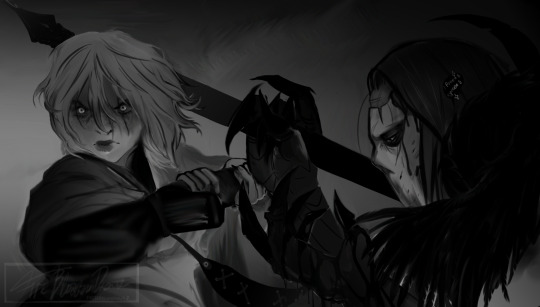
As some of you have known as I have hinted multiple times, that the fanfiction has been up for years and has not received an update other than disclaimers. That's because my only use for it by this point has been as a crude outline for the rewritten version. Which I don’t want to hide either, even if I would like to because of it’s bad attempt at crass subject matter and traumatic concepts that could have been detailed more tastefully. I was an angry kid when I started writing. Thanks to receiving tons of therapy and life development, I feel that I can tackle those subjects from a more realistic standpoint rather than the sheltered worldview that I used to have.
With that being said, certain characters will not receive the significant changes, evil or not. And there will be a list designating who to expect that from and why.
Key characters that will receive no changes in the updates:
• Ostegoth (he deals, he smokes, we love ostegoth in this house and he does no wrong in his choices to pinch a coin/relic!)
• The Lord of Bones and subjects (He is an abusive monarch in cannon. I don’t think I could really rewrite it without sacrificing any personality traits and same goes for everyone else. I gotta keep the plot spicy somehow *shrugs* he keeps his satisfying end.
• Draven (the evil characterization does not suit him at all! For someone as neutral in the story, he’s a mentor and a bro, will remain that way in the update)
List of characters receiving drastic changes:
• Genevieve (Even if the basic layout will remain the same, [Which I will entail in a bio later on!] girl needs a confidence boost amongst other things. I wrote my oc without any experience in the industries that she were in on Earth and I unfairly wrote it out as something that she should be ashamed of. A similar backstory has been made with room to overcome and develop through. I am also adding certain flashbacks as well to highlight her character)
• Vulgrim (overly misogynistic, no chill, not cool. He will have more significance late story to demand changes in his character now)
• All Makers ( some changes of certain terms that could be considered misogynistic (in Thane’s case, thankfully they never made the final cut) but they are written as cinnamon rolls that need not a change other than their butchered dialect. Sorry for those, European readers.
• Death (he is emotionally ambiguous unless it concerns those he cares about. Though, he will be given the least amount of changes within the plot the way it is, but interactions are the main concern. I thought the intimate lines throughout the story were great work and somehow I was commended for them. However, the ones that are close without intimacy such as the first encounter and up to chapter 12, came across to me as far too cold and even the later scrapped chapters after that were the same. It was another situation of traumatic projection that I've long figured out how to handle. His personality is the same, a rude old one with a dark and mysterious emotional wall. One that's breakable with the proper writing and warmth. Y'know, like Fury. Only worse 🙃)
With all of that being said, the fanfiction will remain up to read. I cannot keep u from looking up the outdated version. But know this dude, How to write more ethically came along as well. I am willing to try again.
Doing that in writing this story in comic form in the meantime of the actual writing!
Have a variant for getting this far! 🥰
Thank u!

#Darksiders 2#darksiders death#emblem of the siren comic#darksiders#boostable#dust darksiders#karn#draven darksiders
28 notes
·
View notes
Text
20 Questions for Fic Writers
tagged by @razerathane - thank you~!
1: How many works do you have on AO3/fanfiction.net?
On AO3: 57
I don't remember my ff.net login, it's been so long.
2: What's your total Ao3/fanfiction.net word count?
172,928 words
3: What fandoms do you write for?
Now I focus mainly on the Compilation of FFVII (again), but I have written for Legend of Zelda, Tekken, Sonic the Hedgehog, Yu-Gi-Oh, some FFIX, and some GetBackers and Higurashi.
4: What are your top 5 fics by kudos?
two guys and a gondola (Barret & Cloud)
reunions & new beginnings (a touch of VinVeld)
Control, or The Lack Thereof (written for Chaos Theory)
a nice, quiet country life (Zack/Aerith, hinted Zack/Aerith/Cloud)
a lost art (Sephiroth/Genesis)
5: Do you respond to comments? Why or why not?
I should, and I did for a bit before stopping. Mostly because I get shy, but I promise to try to get better about it.
6: What is the fic you wrote with the angstiest ending?
Probably 'etched in glass,' since it centers around Vincent flashing back to an incident in Hojo's laboratory. There's also 'welcome to my nightmare,' which features Vincent losing control of Hellmasker in the midst of battle…
7: What's the fic you wrote with the happiest ending?
'three little words.' Hands down. There's even a beautiful piece I commissioned to go with it~
8: Do you get hate on fics?
I think I got one comment that was just "uh, what," and I shrugged it off. I don't write popular enough pairings regularly enough to get hate, methinks.
9: Do you write smut? If so, what kind?
Yes. Mainly VinRei (my canon/OC pair), and it literally goes from sweet to racy. I've written sweet lovemaking, and Chaotic semi-monsterfucking.
10: Do you write crossovers? What's the craziest one you've written?
I used to because I was in LJ roleplay communities years ago, and a lot of crackships were forged there. Vincent/Nabooru, Ban Midou/Rider (GetBackers/Fate Stay Night), angsty Dark Link & Aerith, a twisted father/daughter relationship between Akabane & Rena Ryuugu (GB and Higurashi), Kadaj and Rinoa were getting cute, and then there was the big sister/little brother dynamics of Cain and Nabooru (GodChild and Zelda: OoT)… I think I have a list somewhere of all the crackships and friendships between characters, lol
I do have an idea for a one-off crossover fight piece that I've discussed with a friend… stay tuned~
11: Have you ever had a fic stolen?
I don't think so, but now I'm feeling a little paranoid…
12: Have you ever had a fic translated?
Nope. Well, not that I know of.
13: Have you ever co-written a fic before?
My late best friend and I co-wrote Zelda and Yu-Gi-Oh crackfics all throughout high school and college; never published because we did it just for fun and for our friend group, and I still have it all, including a bunch of artwork she did for them.
14: What's your all time favorite ship?
Vincent/Reilena, my FFVII canon/OC ship.
15: What's a WIP you want to finish but doubt you ever will?
Both 'Sands of Desire' (a YGO AE canon/OC fic I was writing, and suddenly dropped; to this day I still know exactly how I would end it) and 'Bleeding Angel' (Tekken, OCs, spanned Tekken 3, Tag, and 4, but I quit writing it when 5 came out).
'Sweet Lady Luck' is the Final Fantasy VII Casino AU that I keep posting little scenes for, that I swear I will get started posting actual chapters for THIS FUCKING YEAR, because I have so much planned for it, and I love it and them so much. So that is a WIP that I WILL finish, come hell or high water.
16: What are your writing strengths?
Characterization and emotion; I think I have a pretty good grip of character personalities.
17: What are your writing weaknesses?
Sometimes dialogue or just knowing when to END a scene.
18: Thoughts on writing dialogue in another language in fic?
I used to be super cheesy about it (think old-school fansubs lol), now I try not to do it altogether; if it happens, the dialogue will be put in brackets to designate it as being in another language. If you can get it to work though, that's awesome~
19: First fandom you wrote for?
Legend of Zelda: Ocarina of Time
20: Favorite fic you've written?
Honestly? Right now it's tied between 'three little words' and 'when chaos and passion collide.' Both VinRei pieces, one sweet and emotional, the other smutty and emotional.
Feel free to snag this if interested!
3 notes
·
View notes